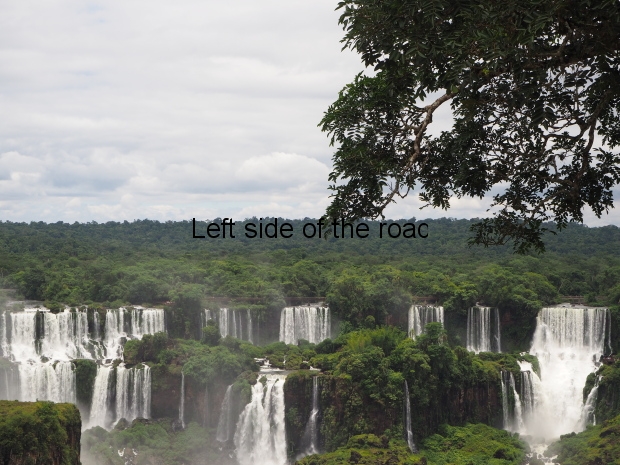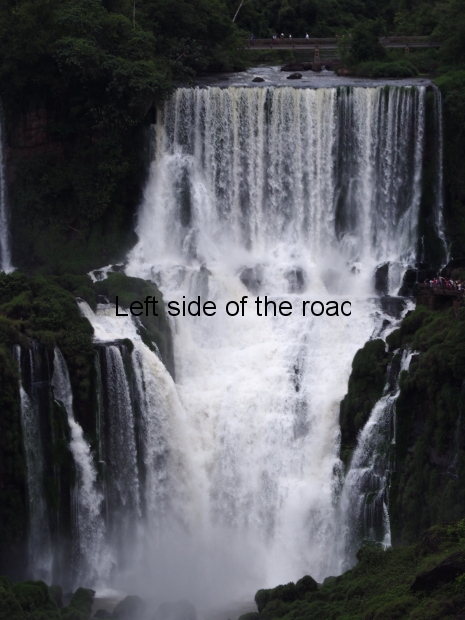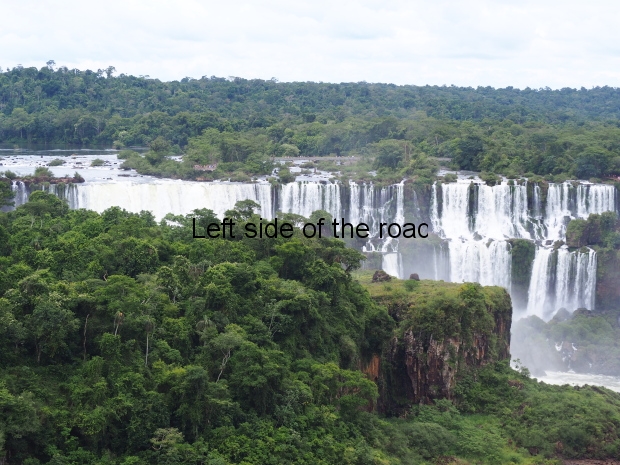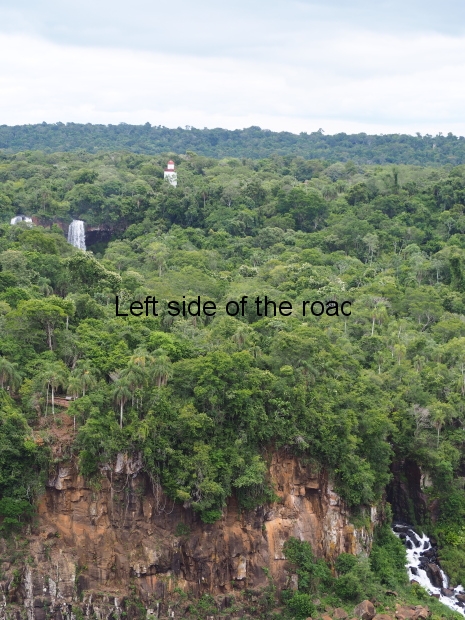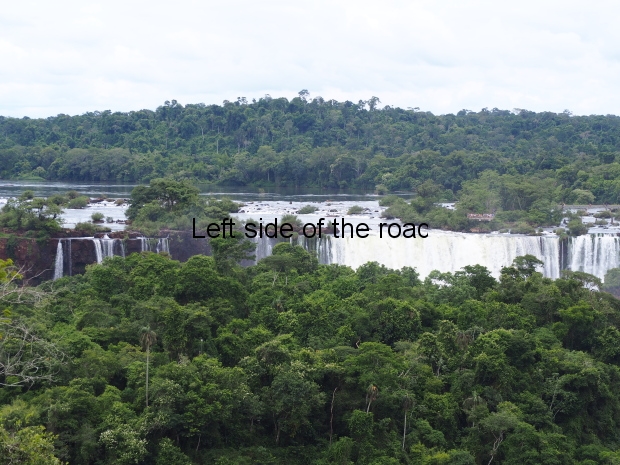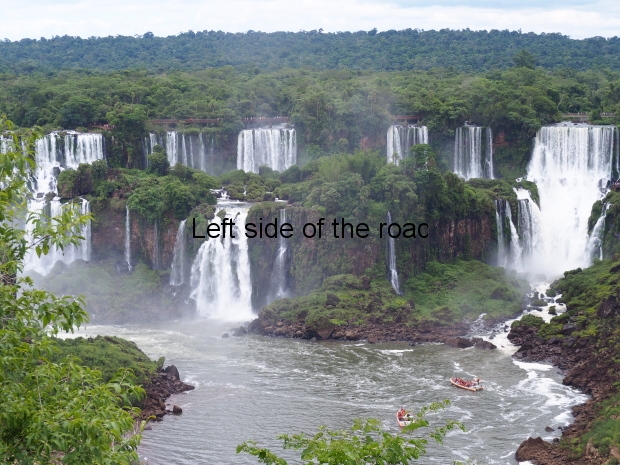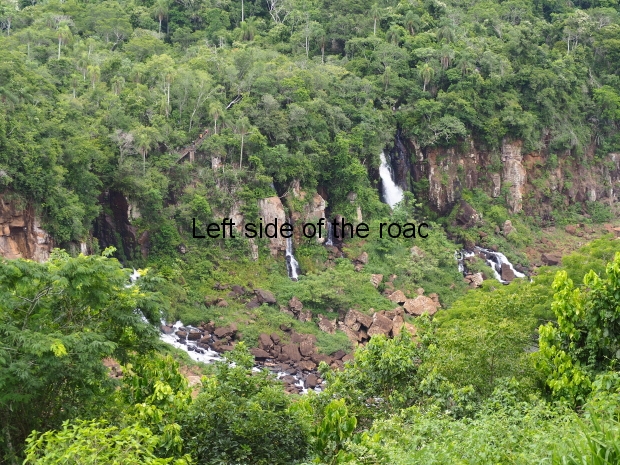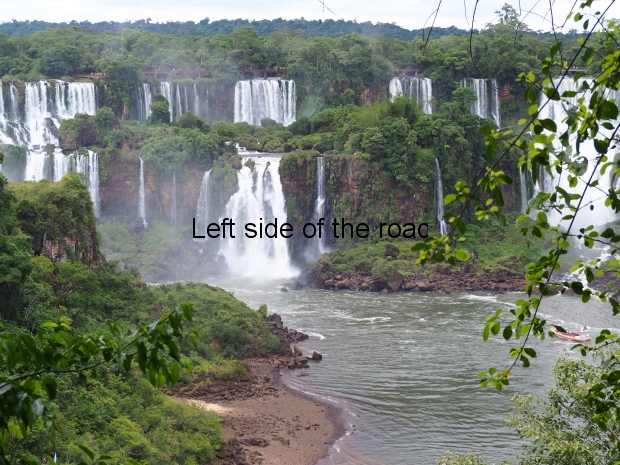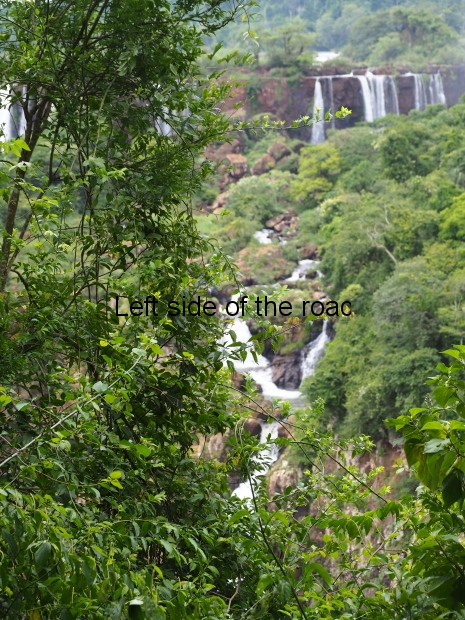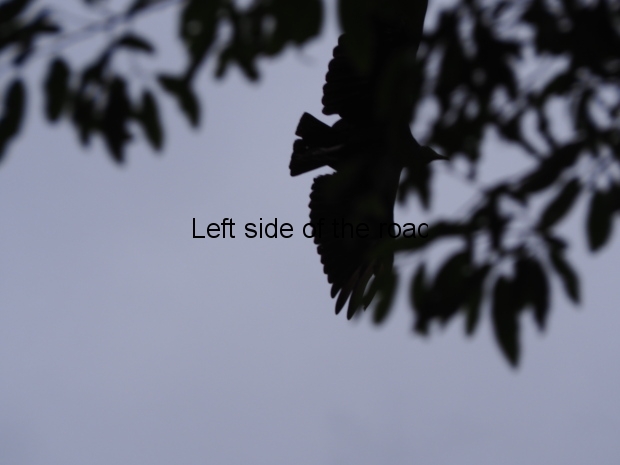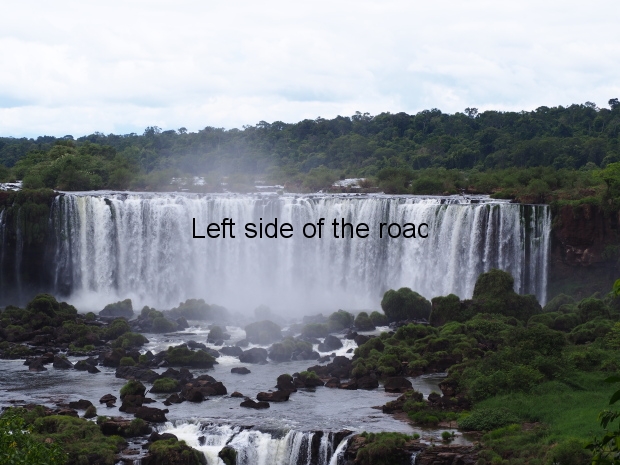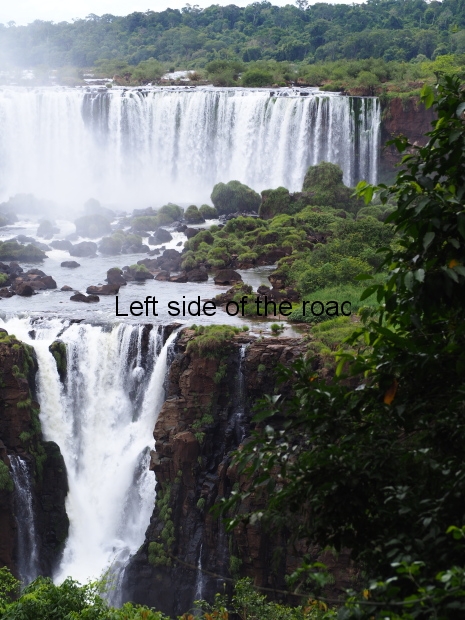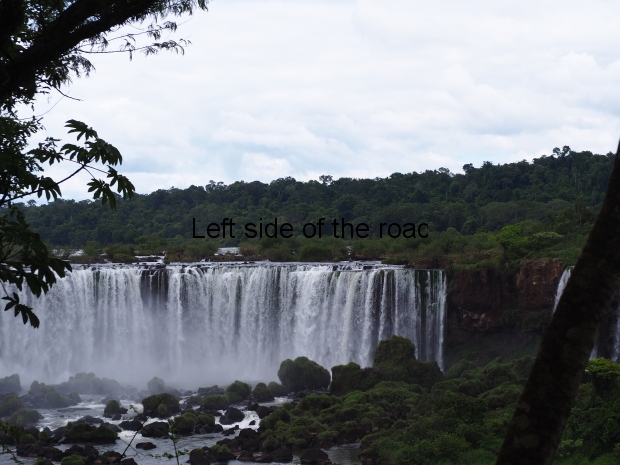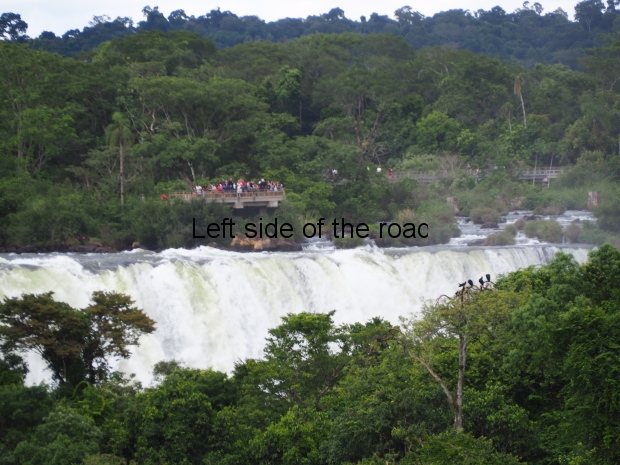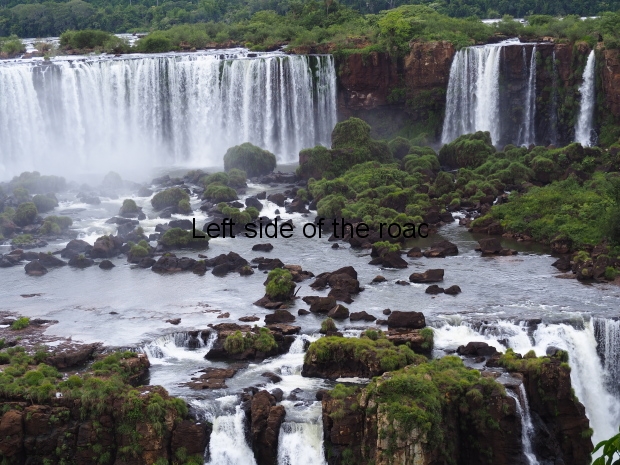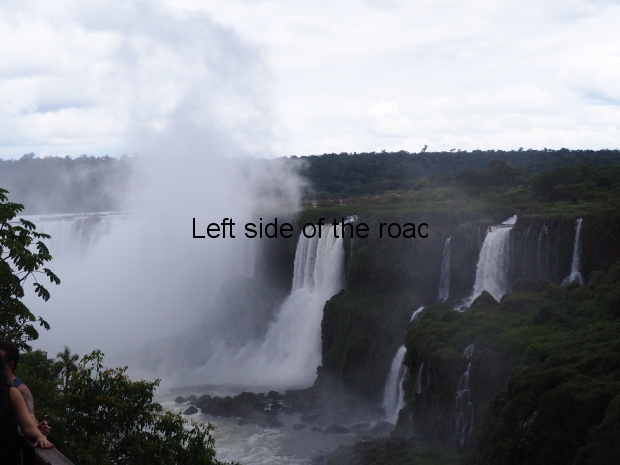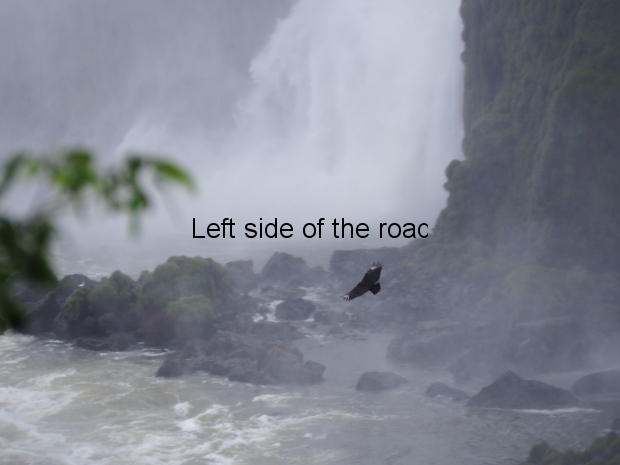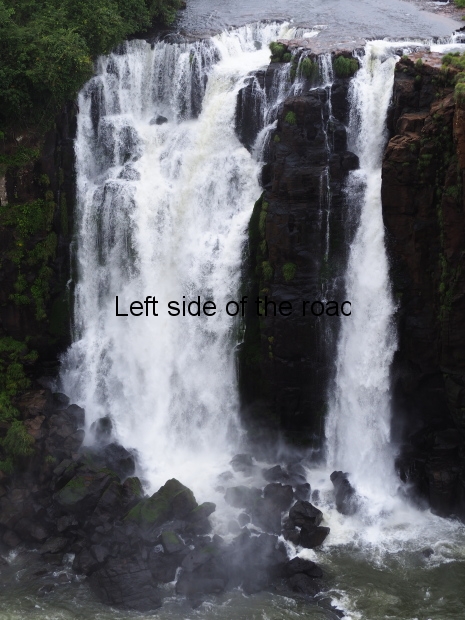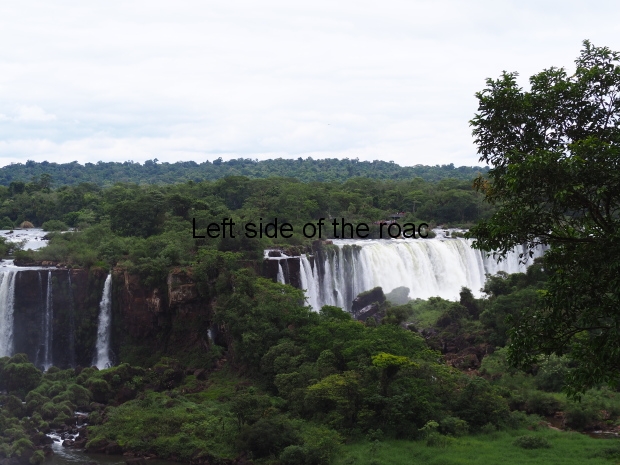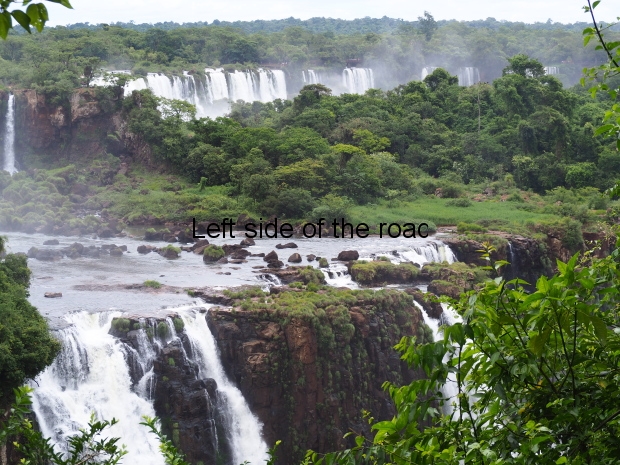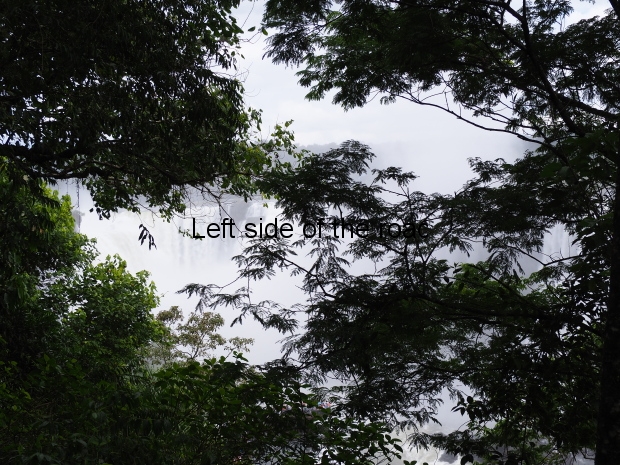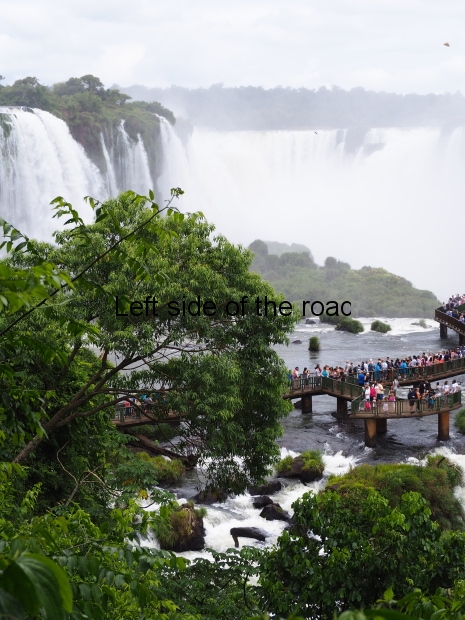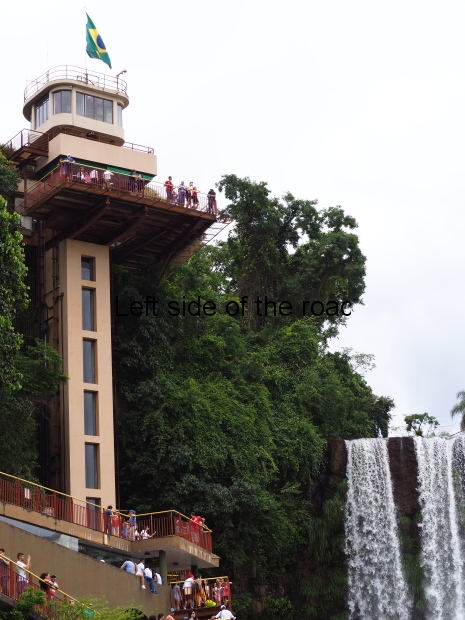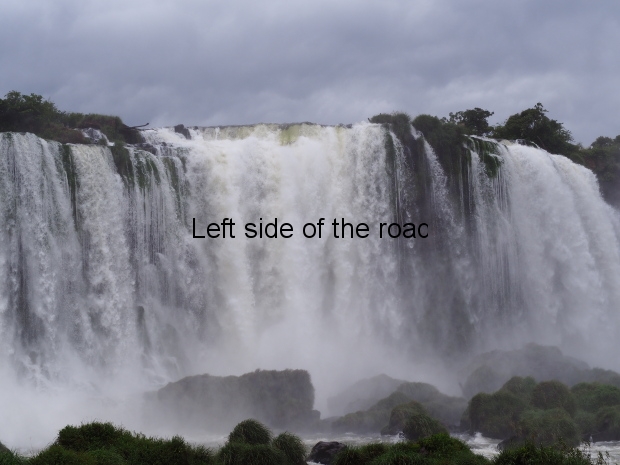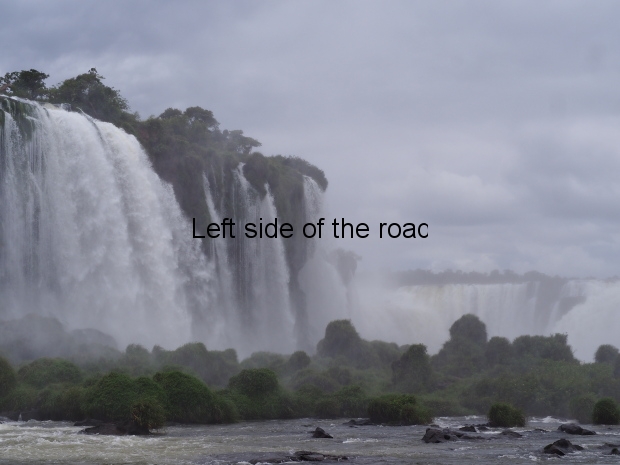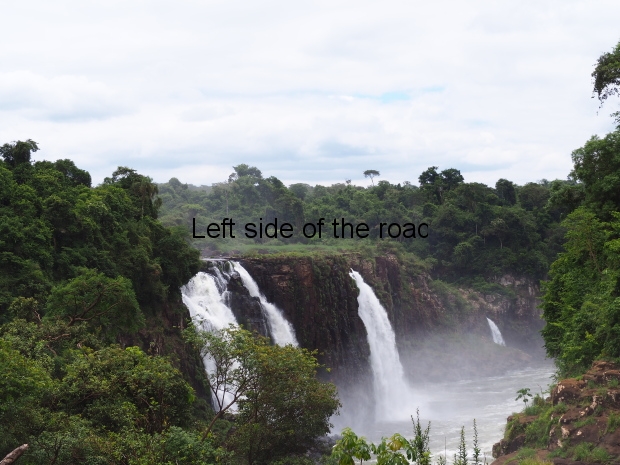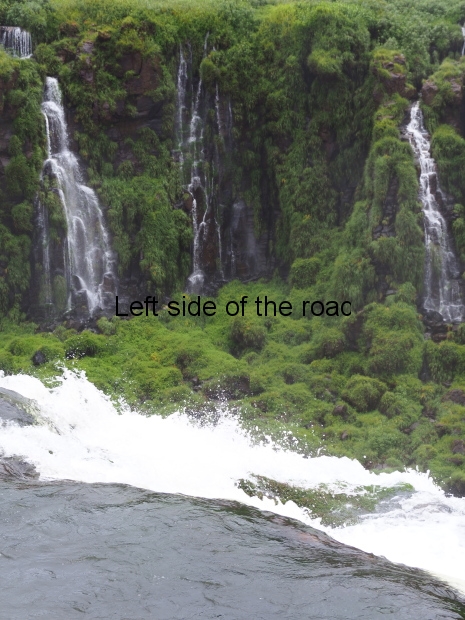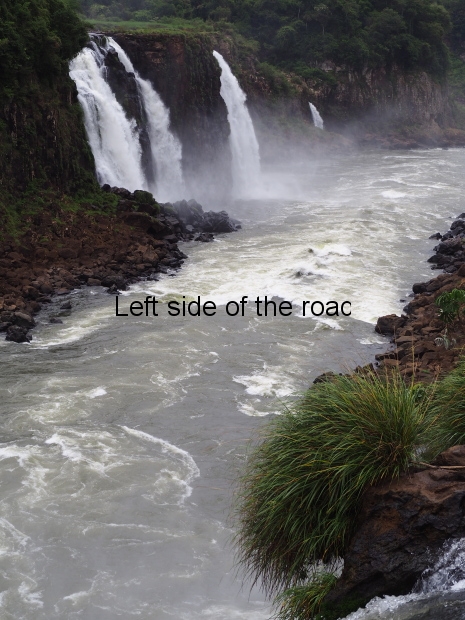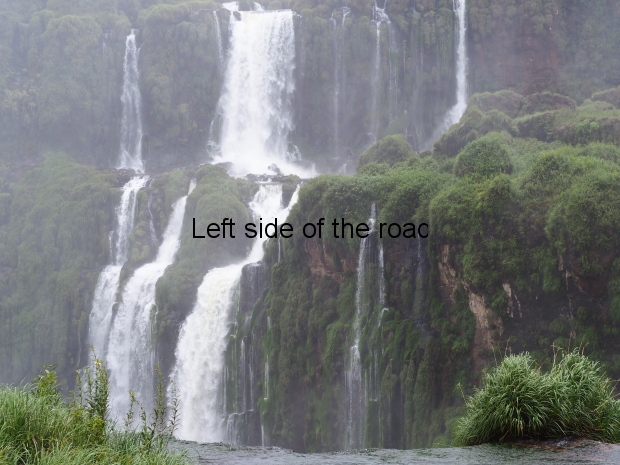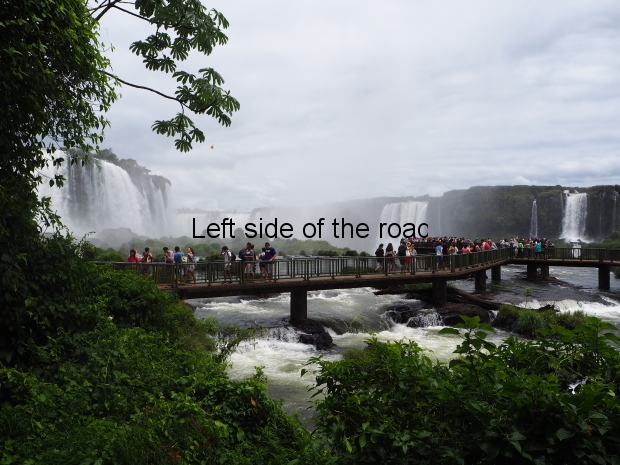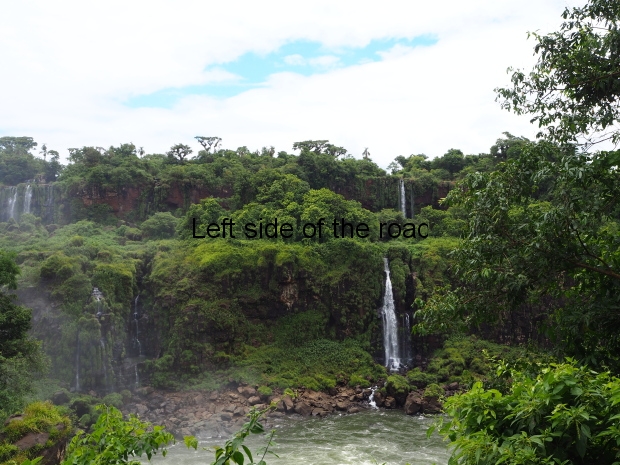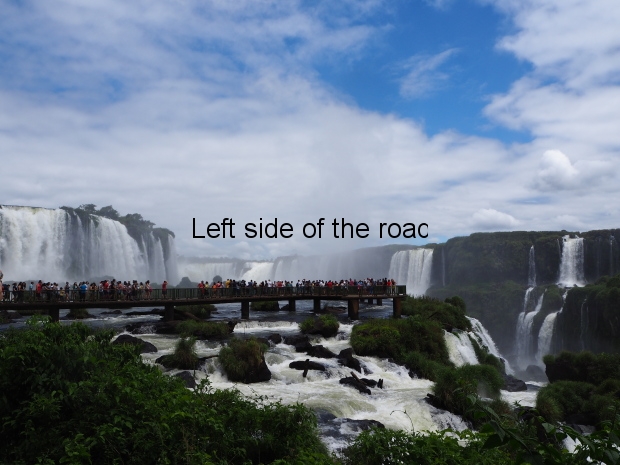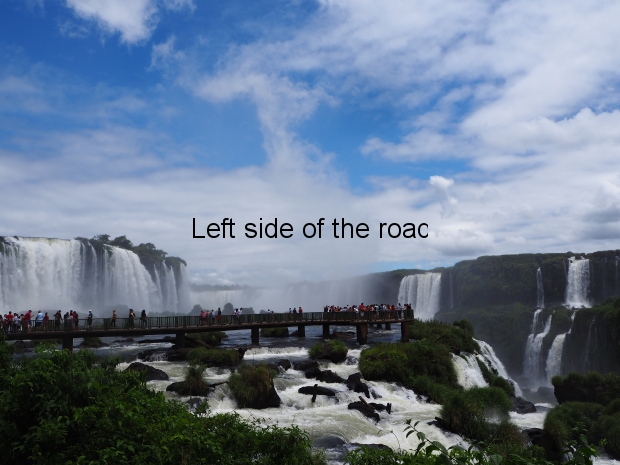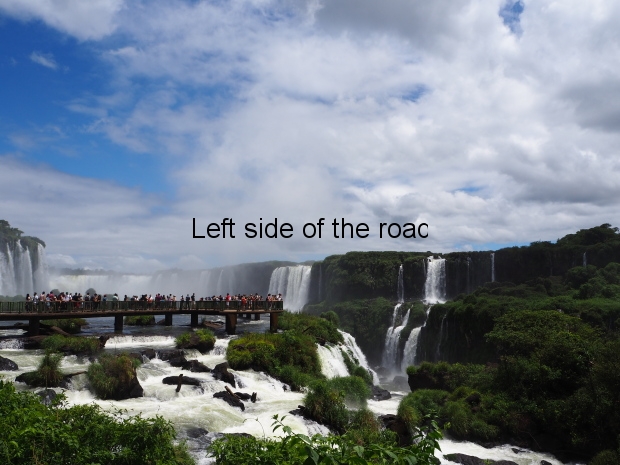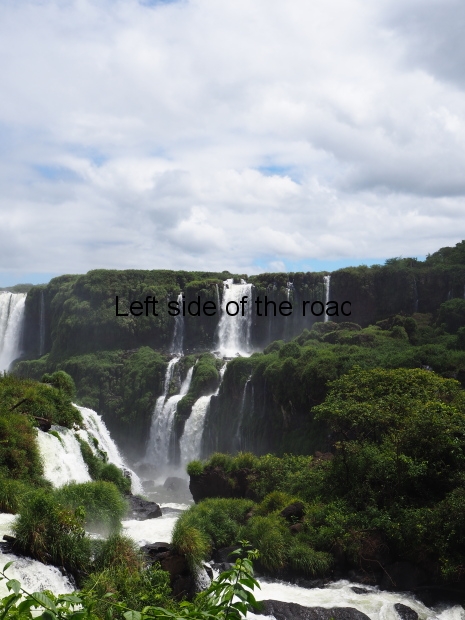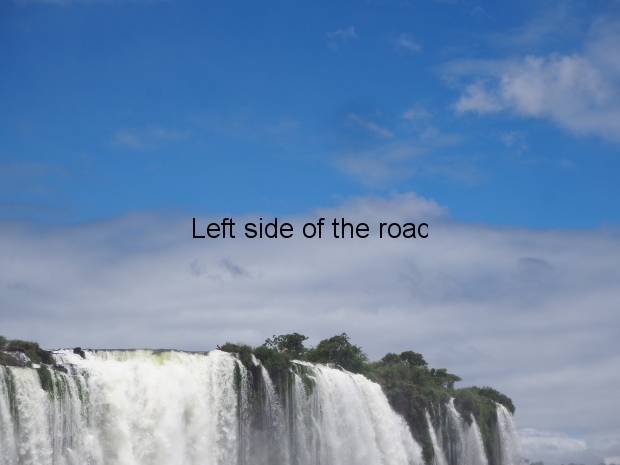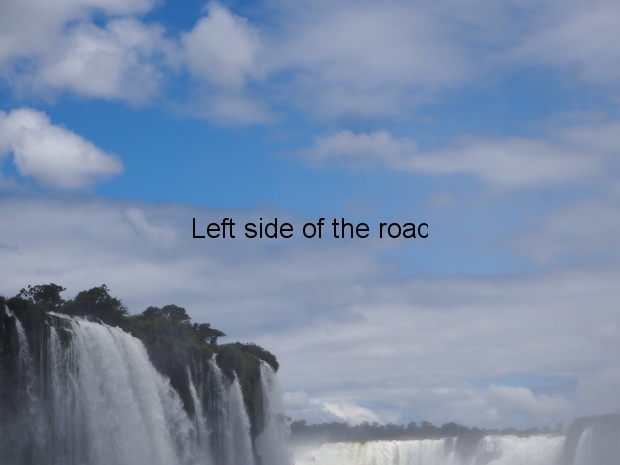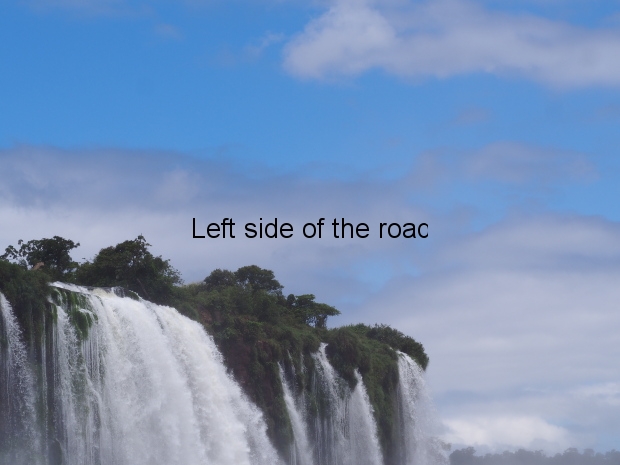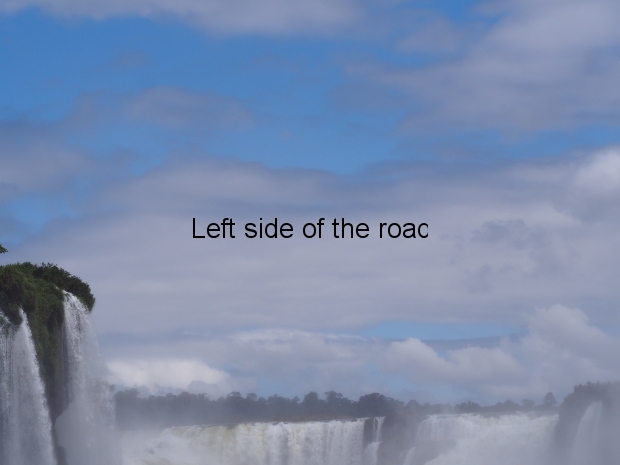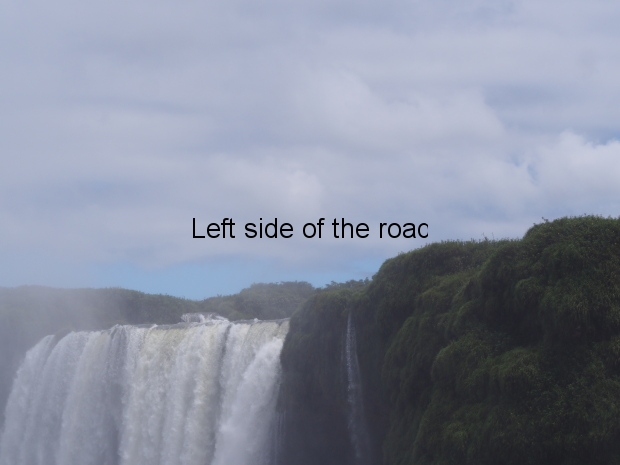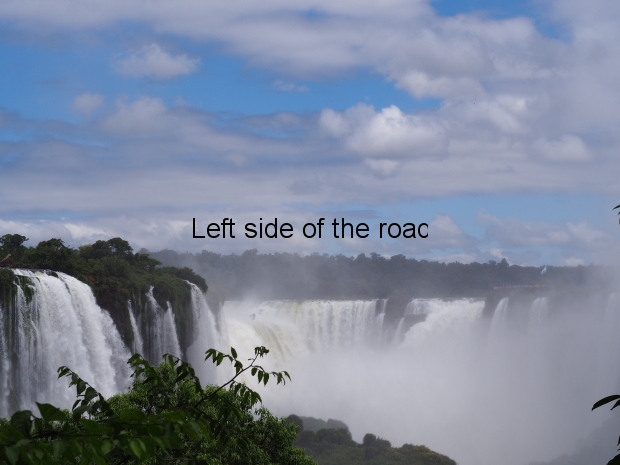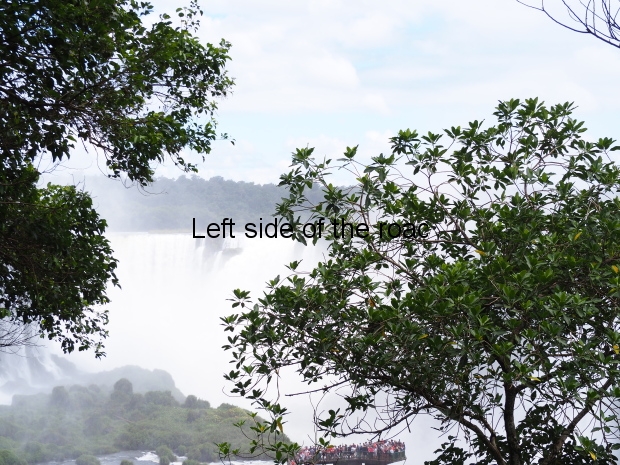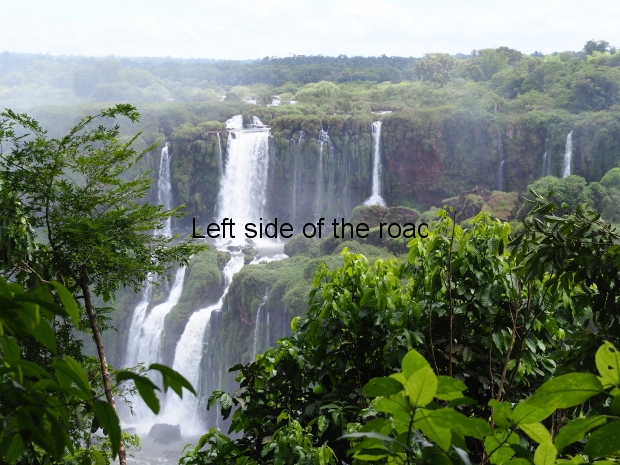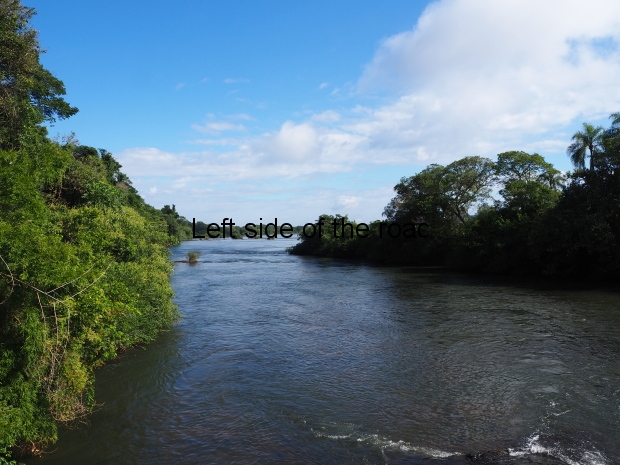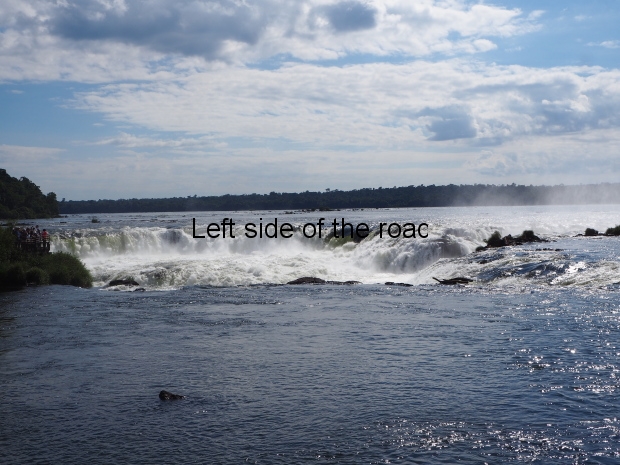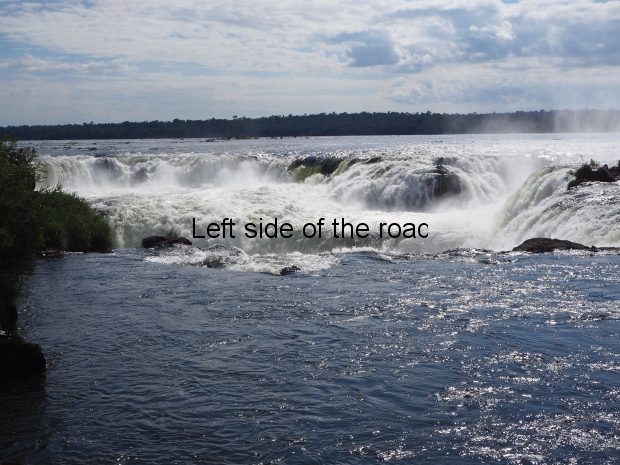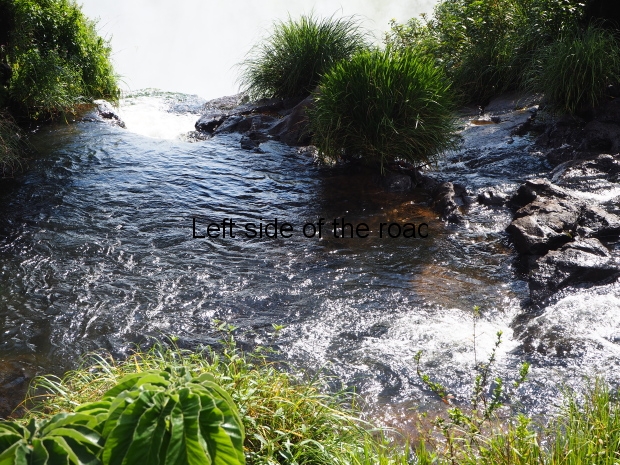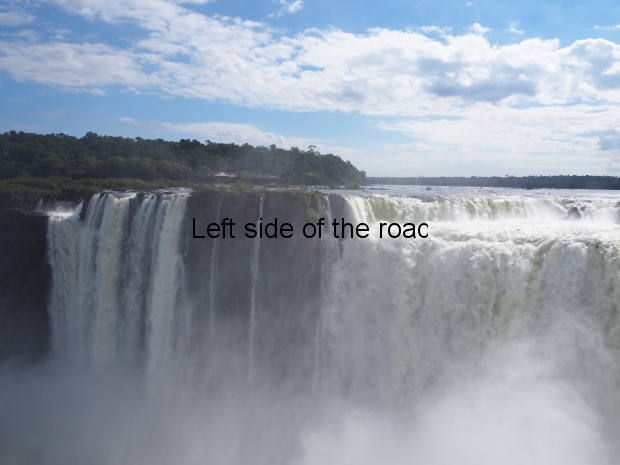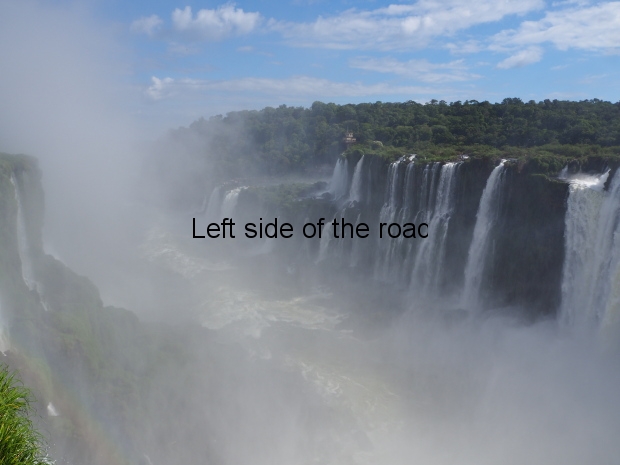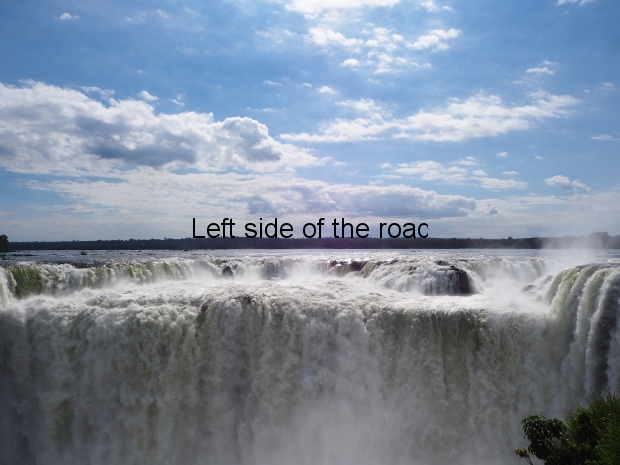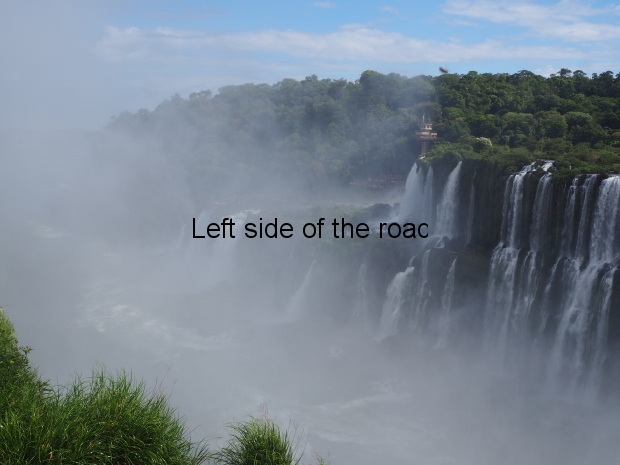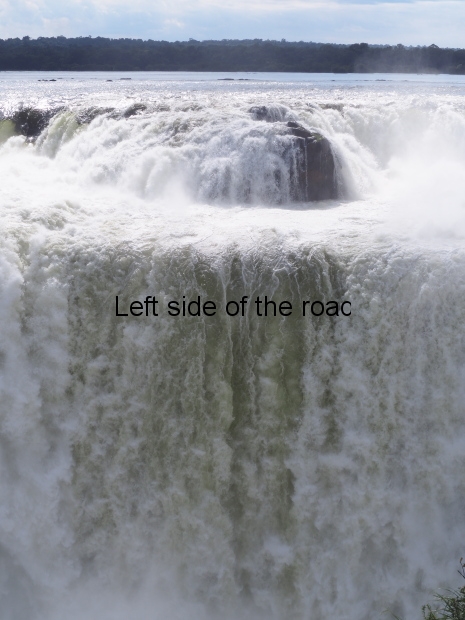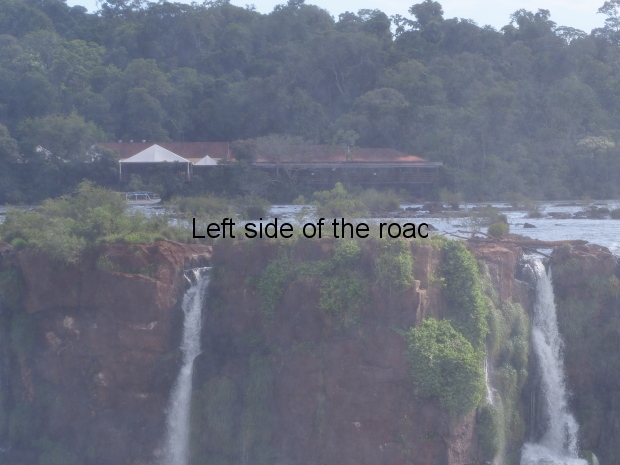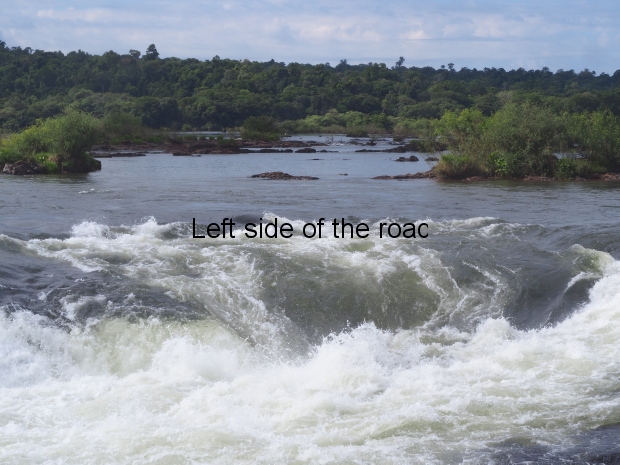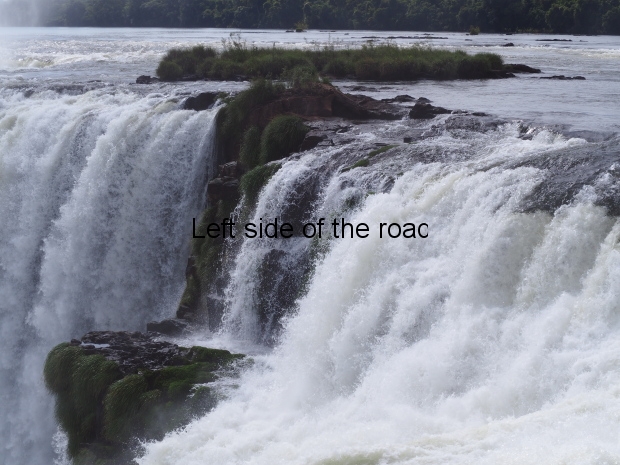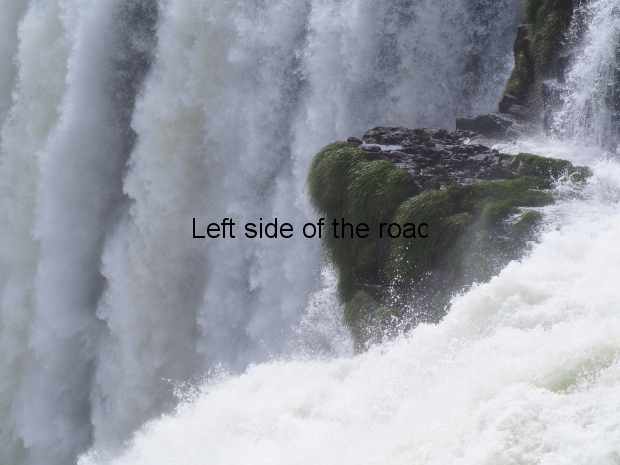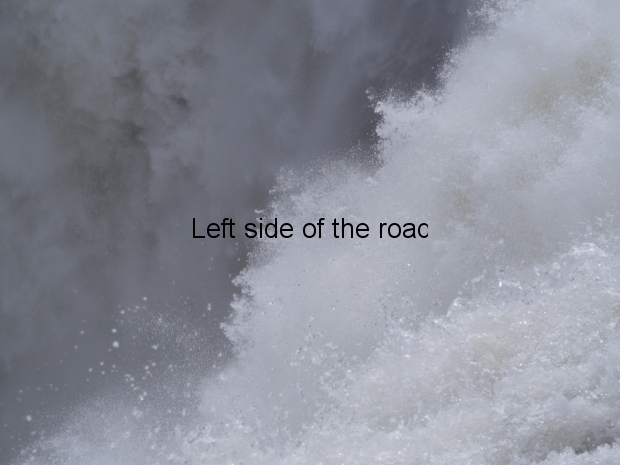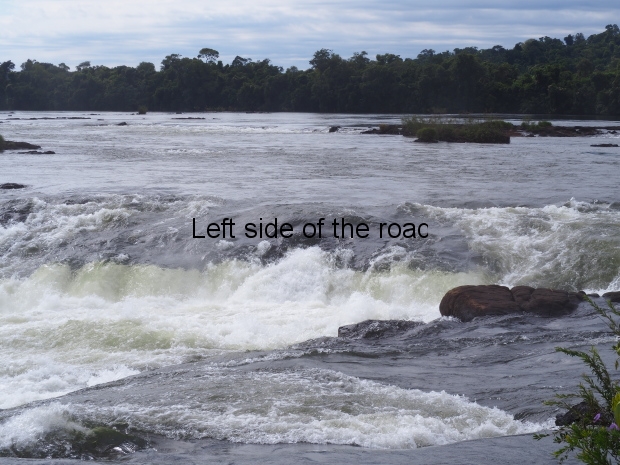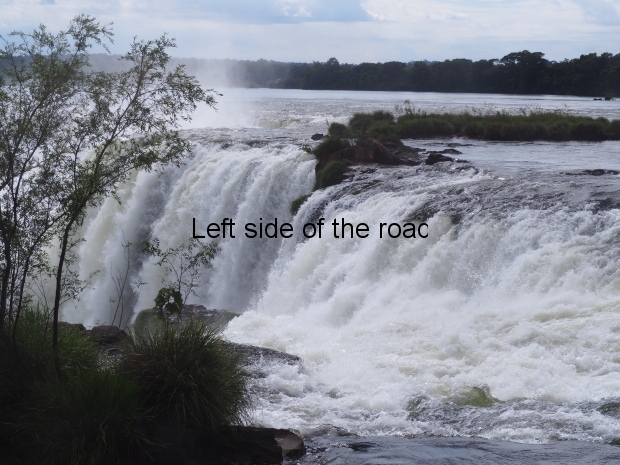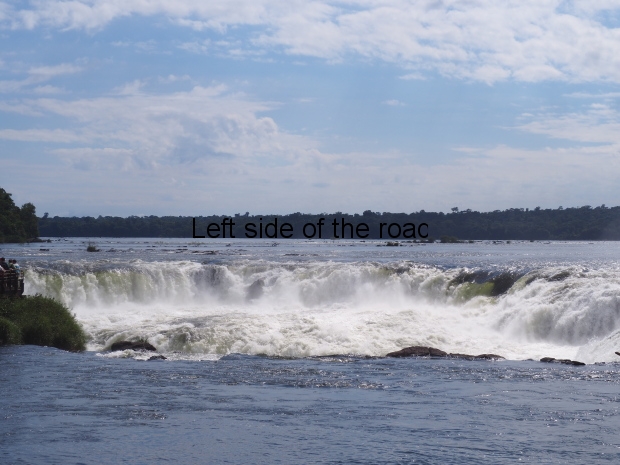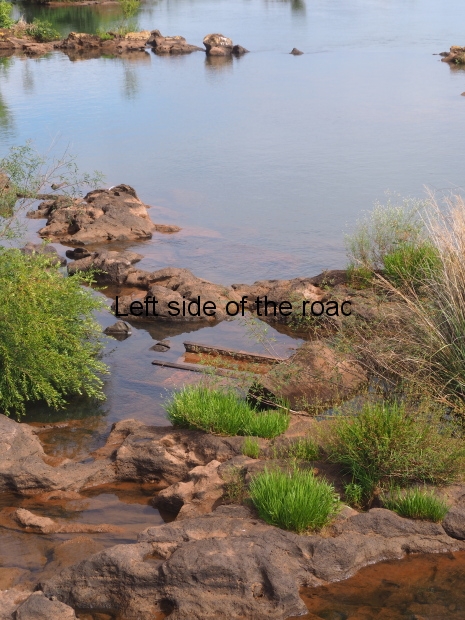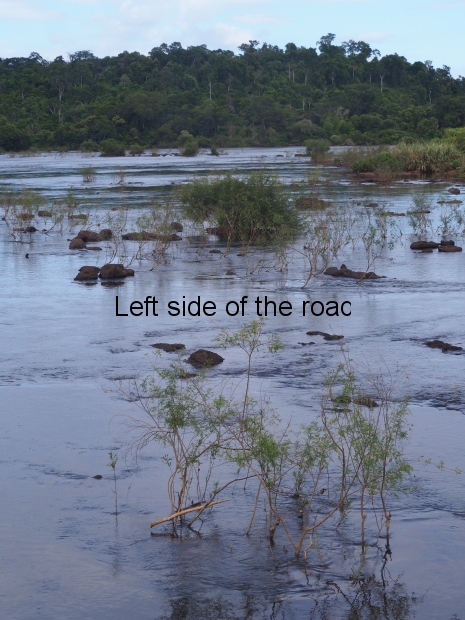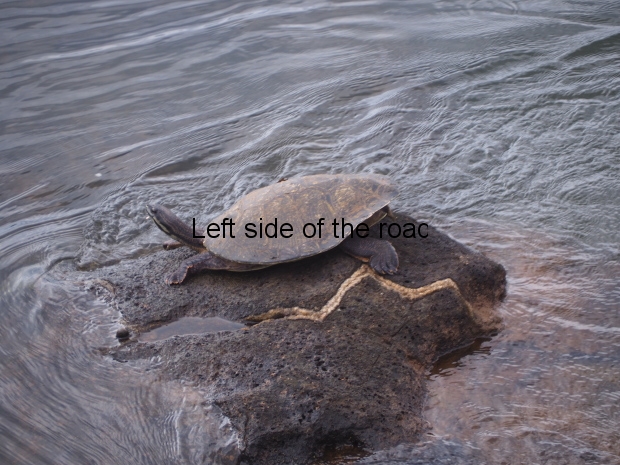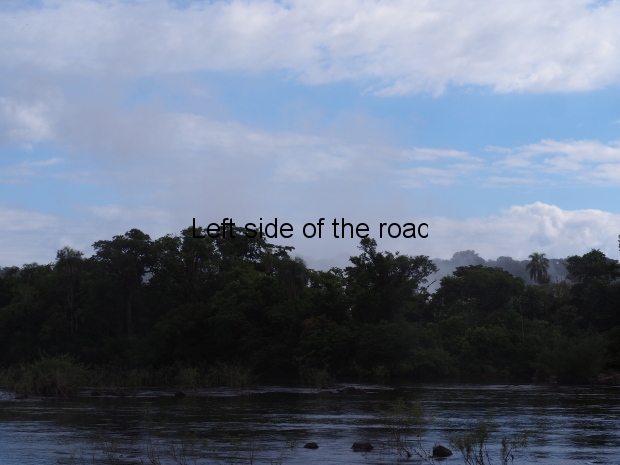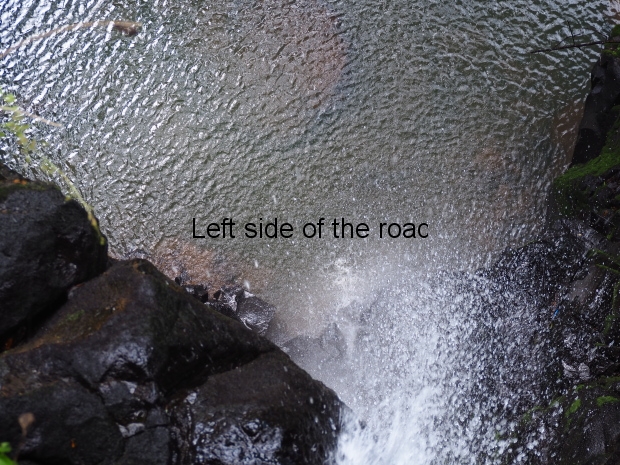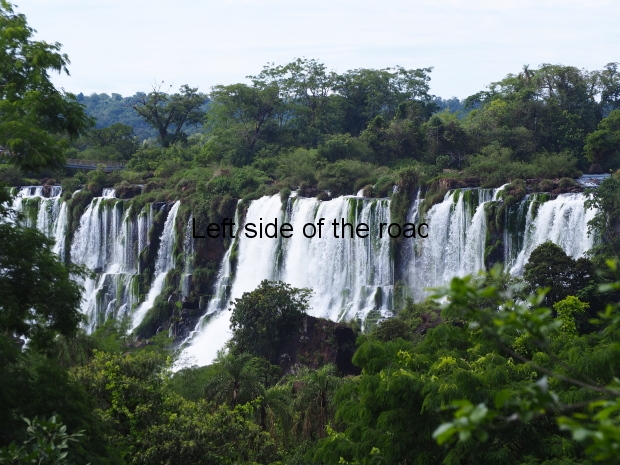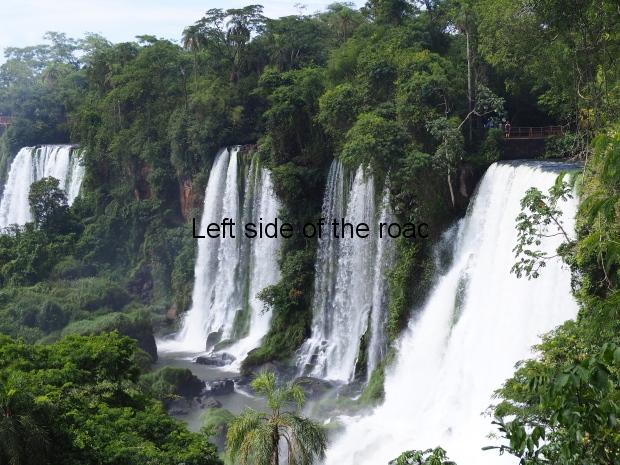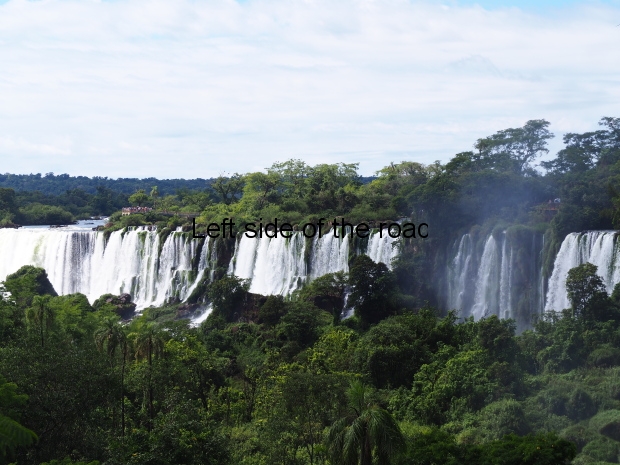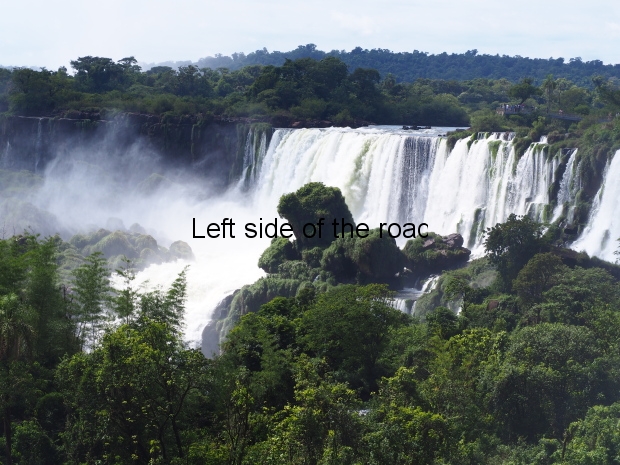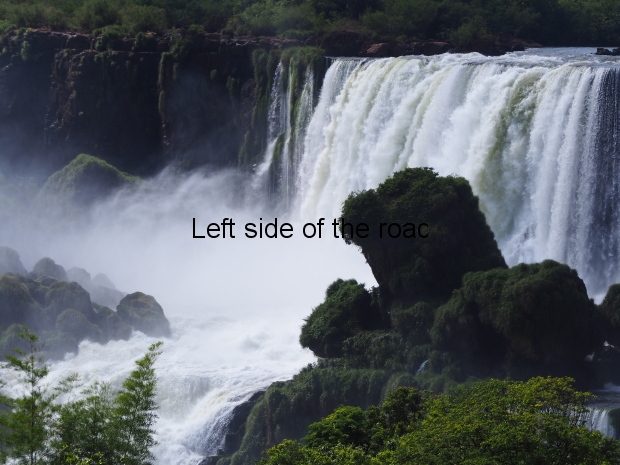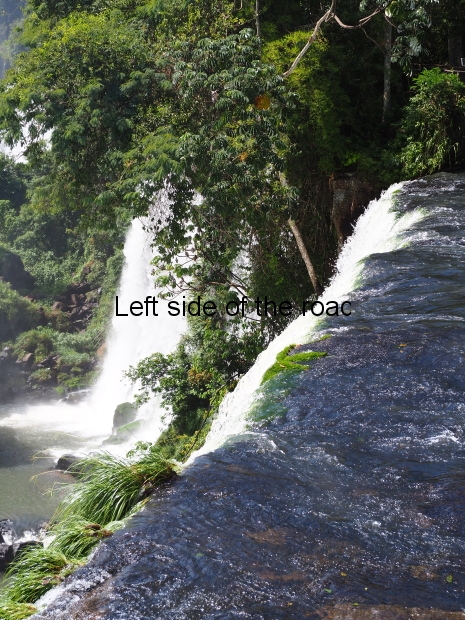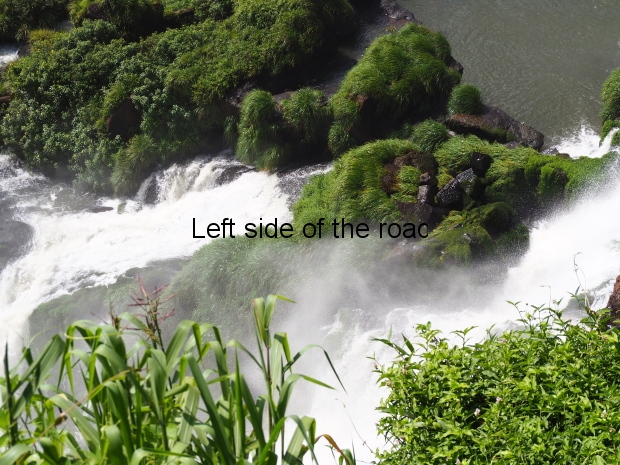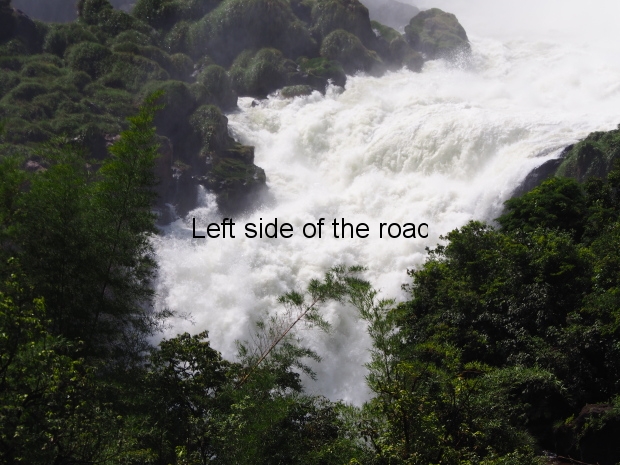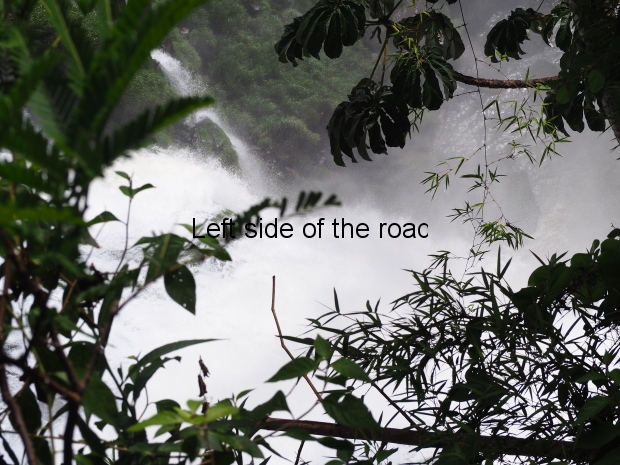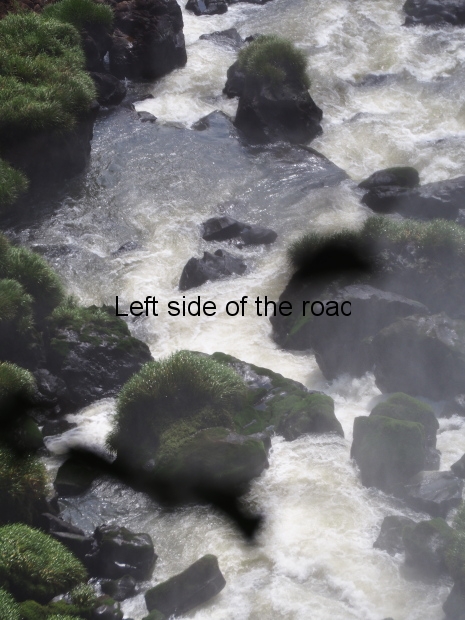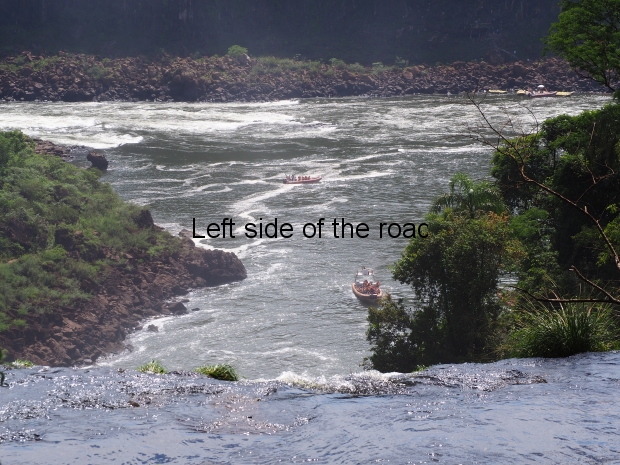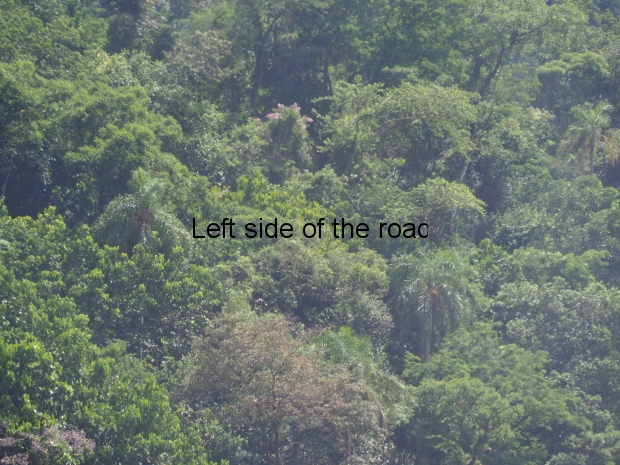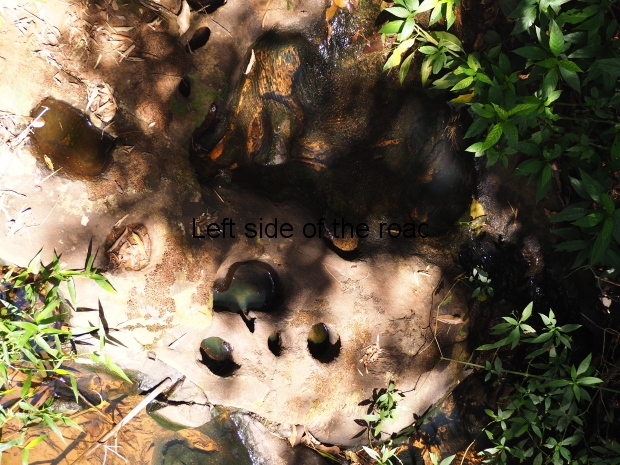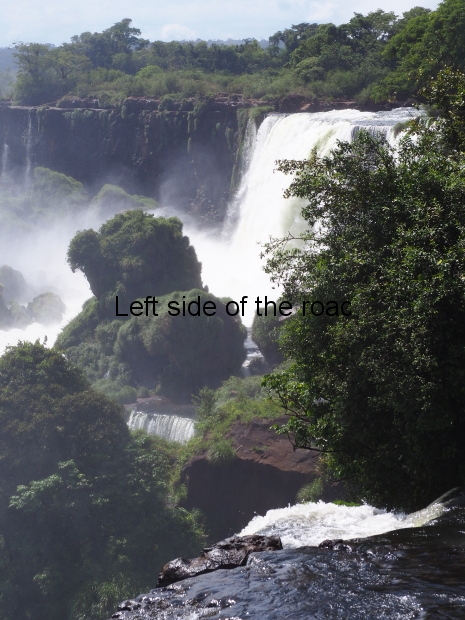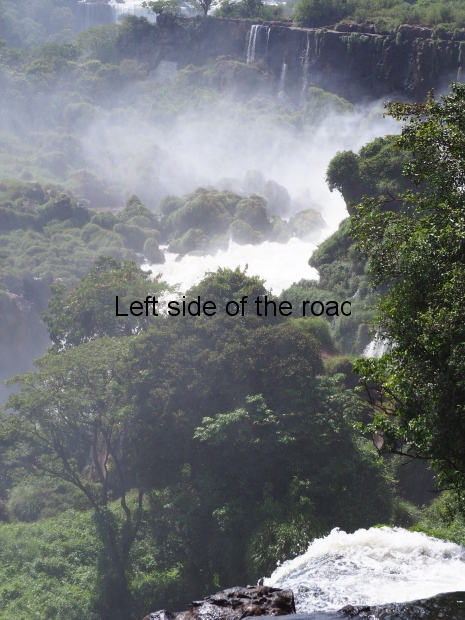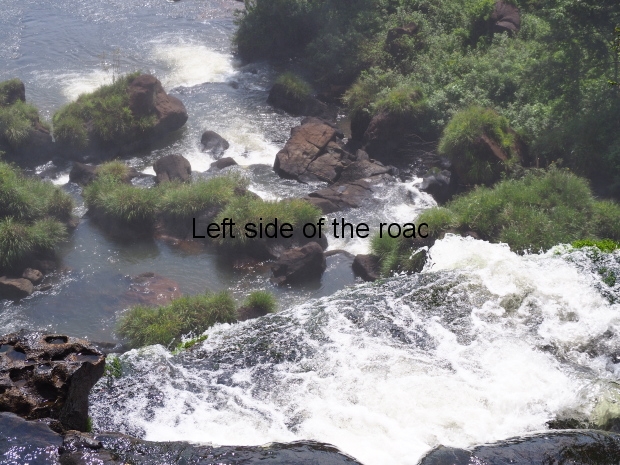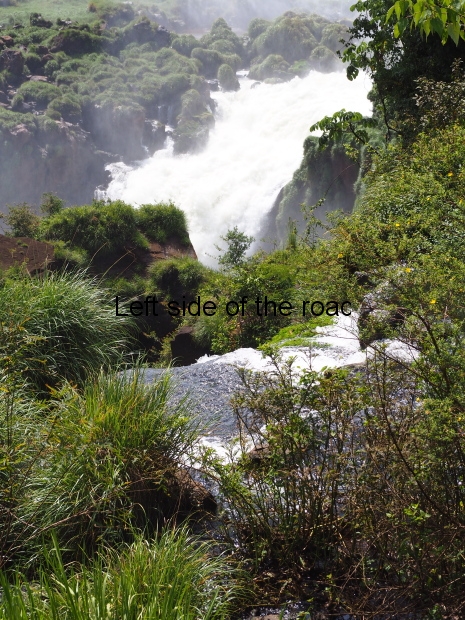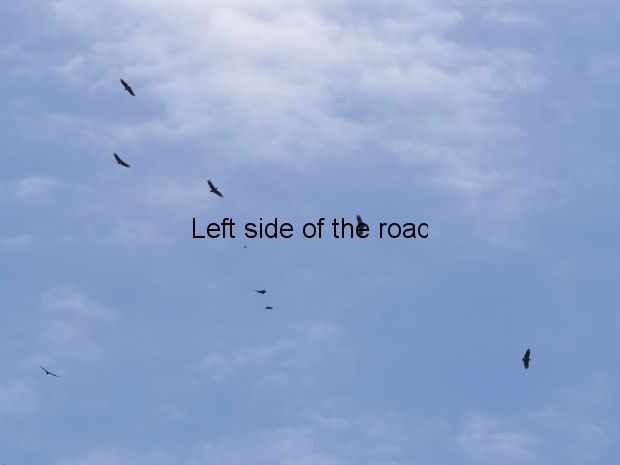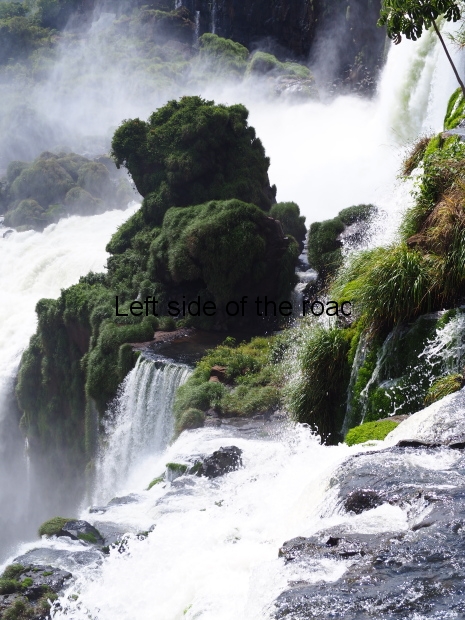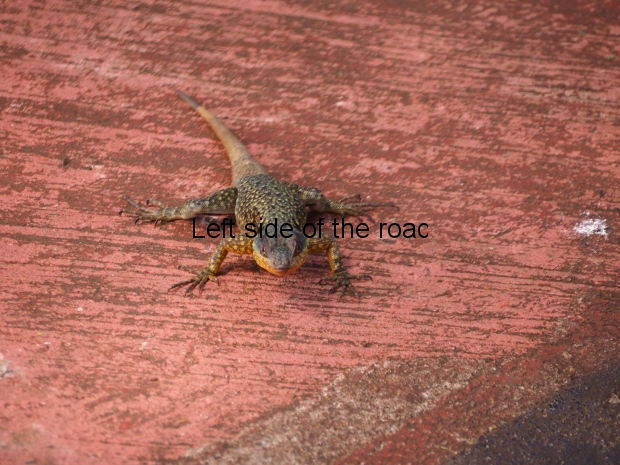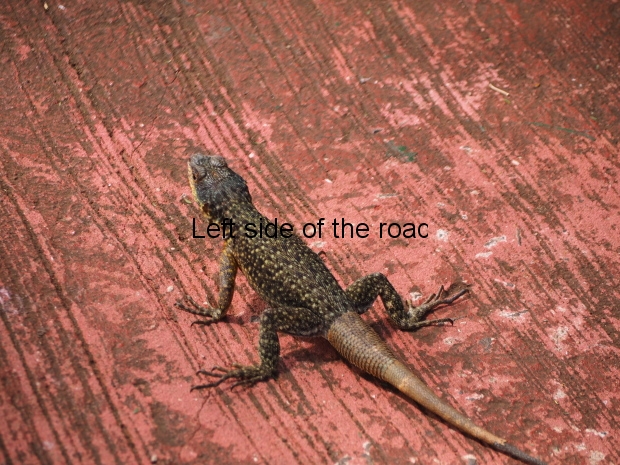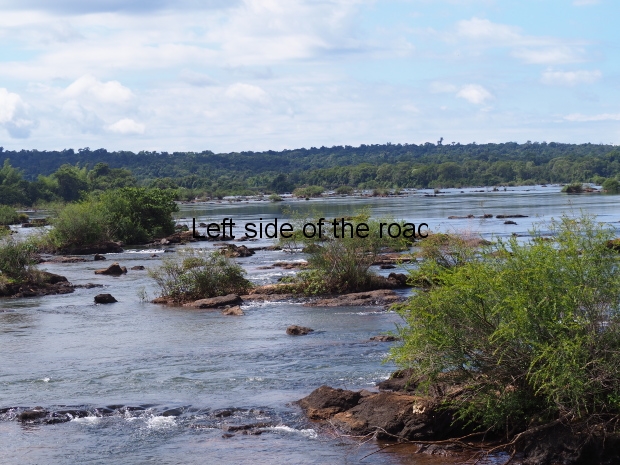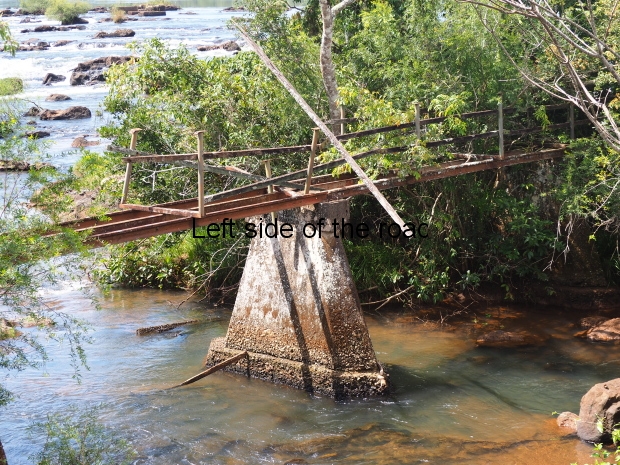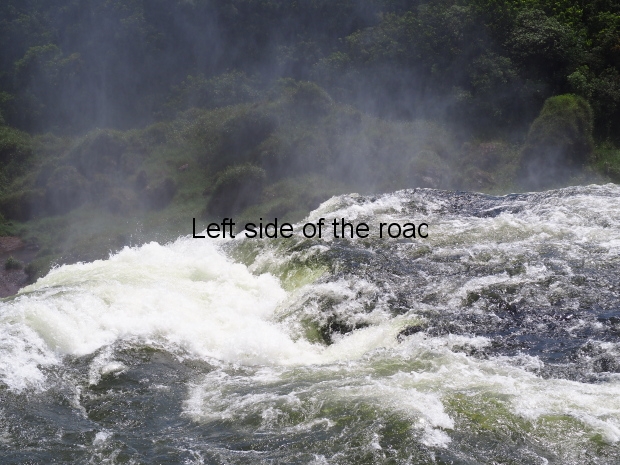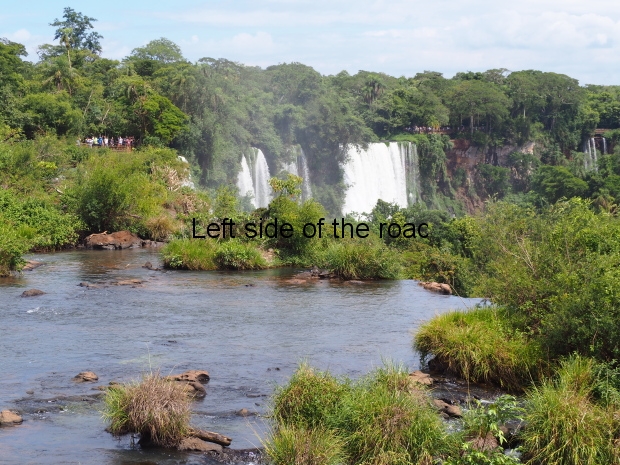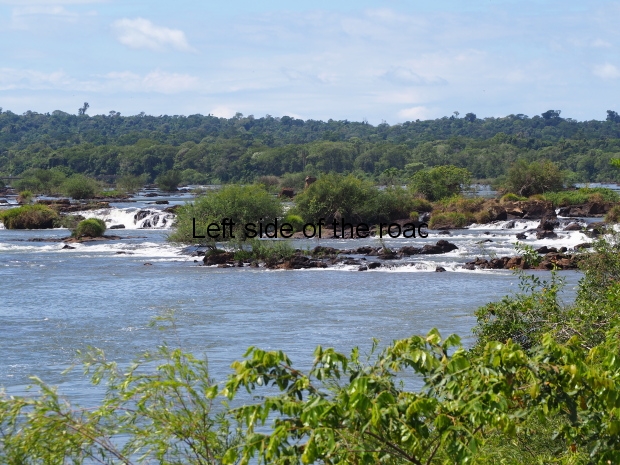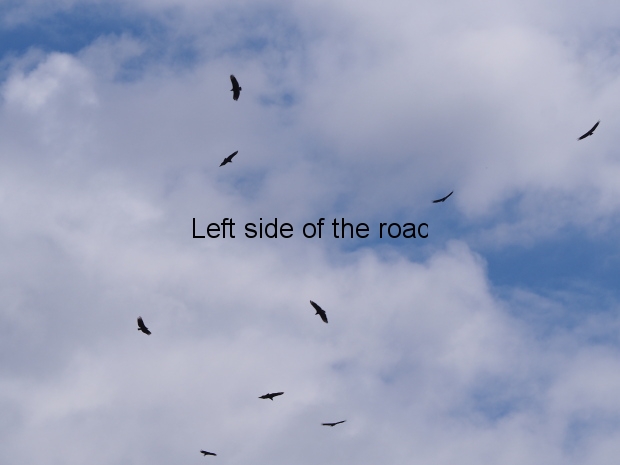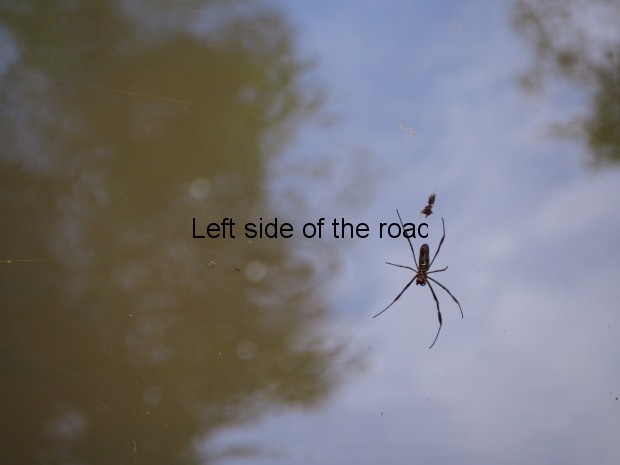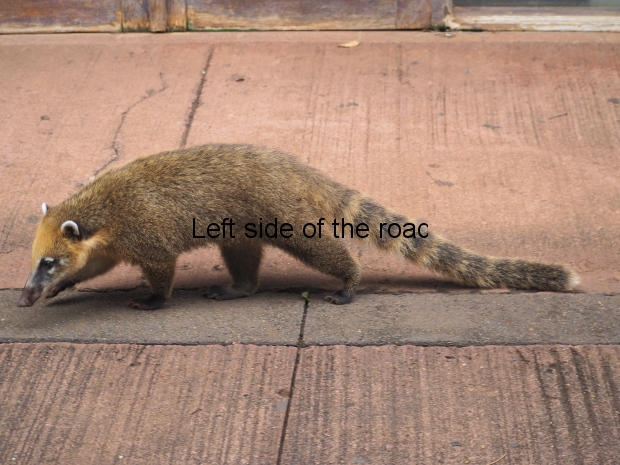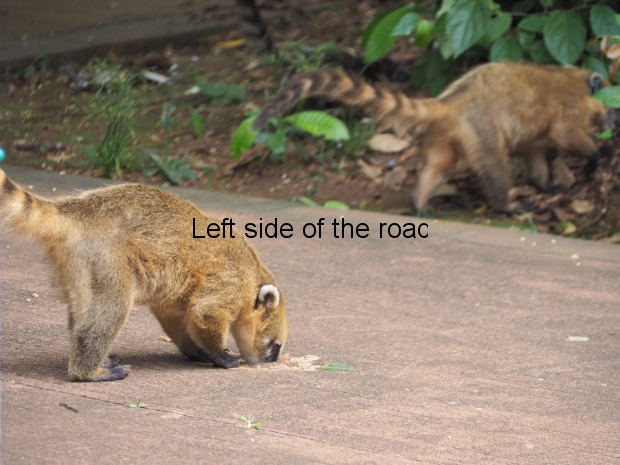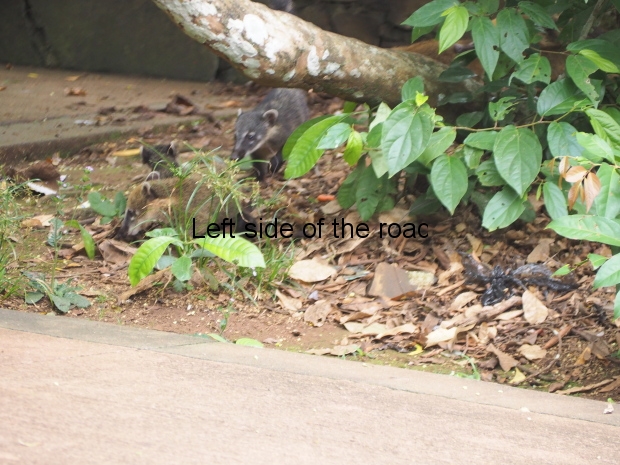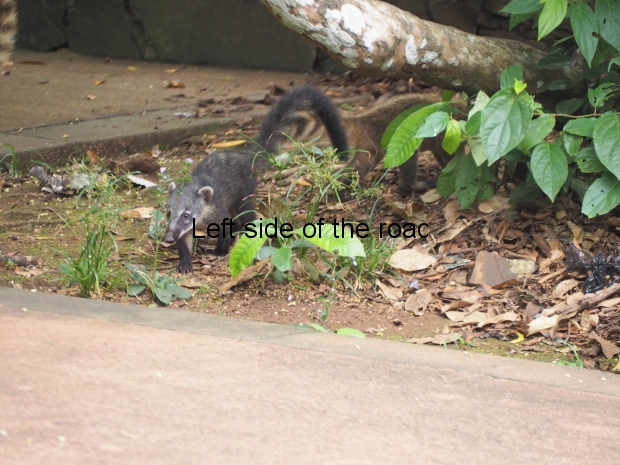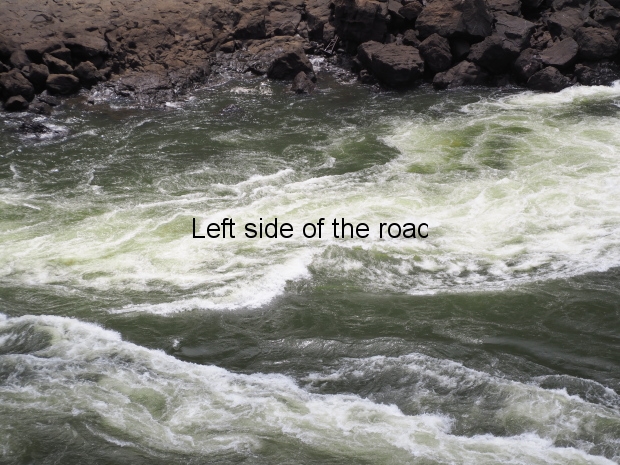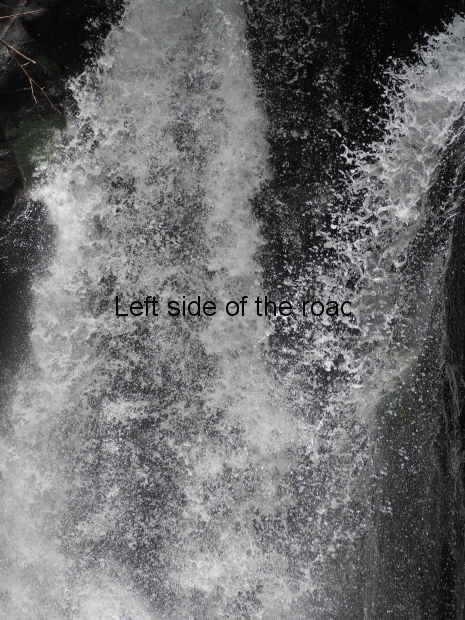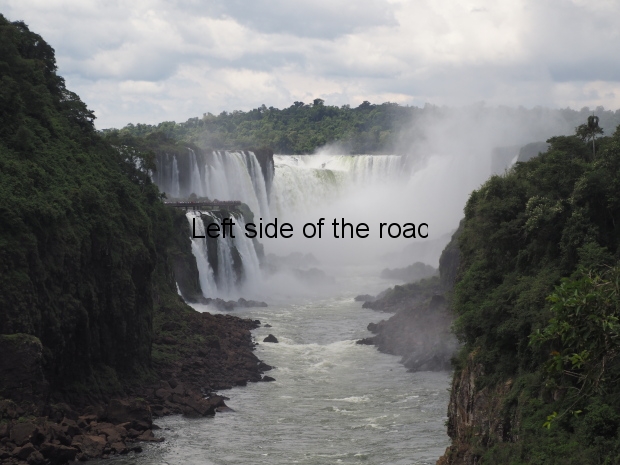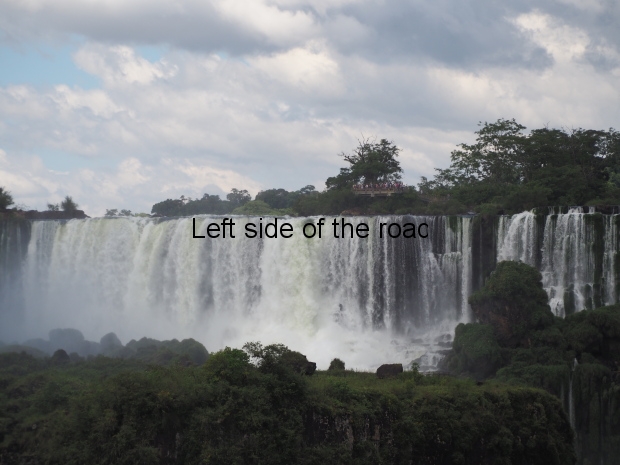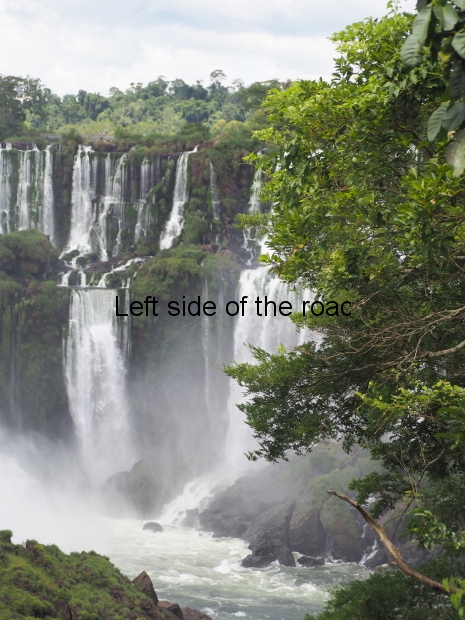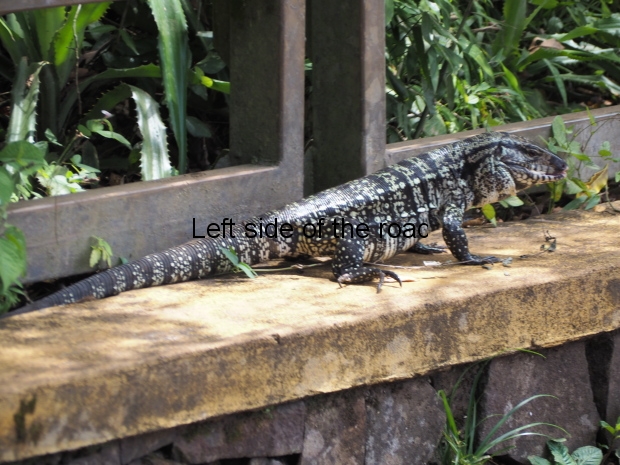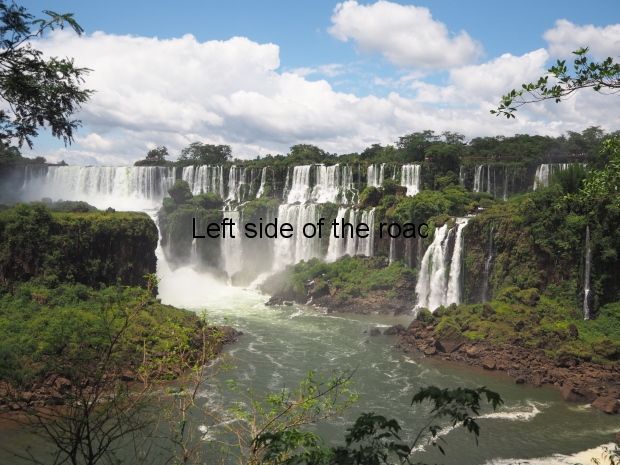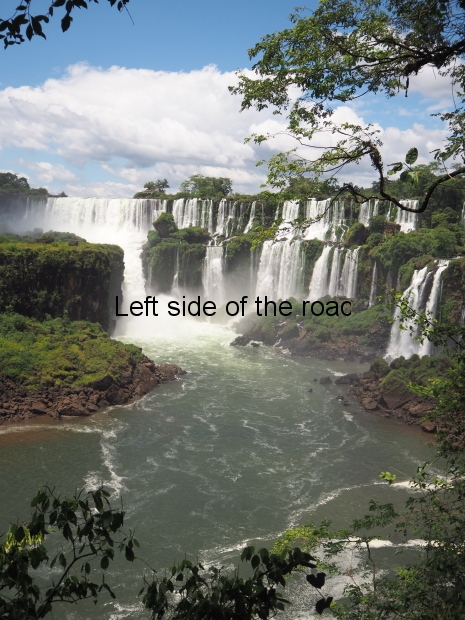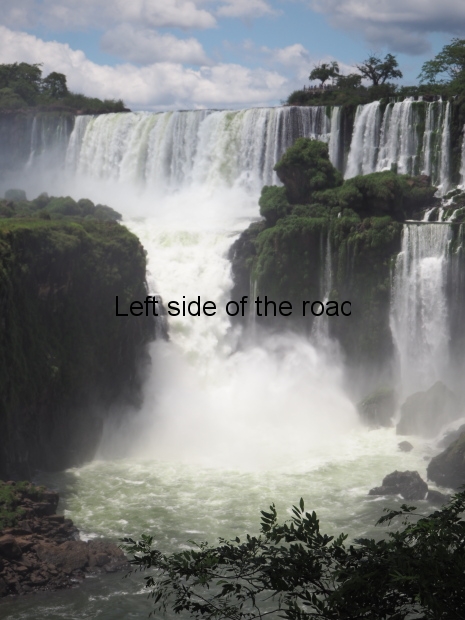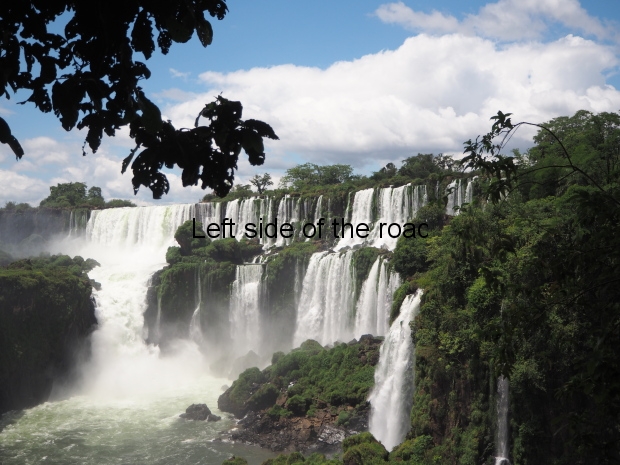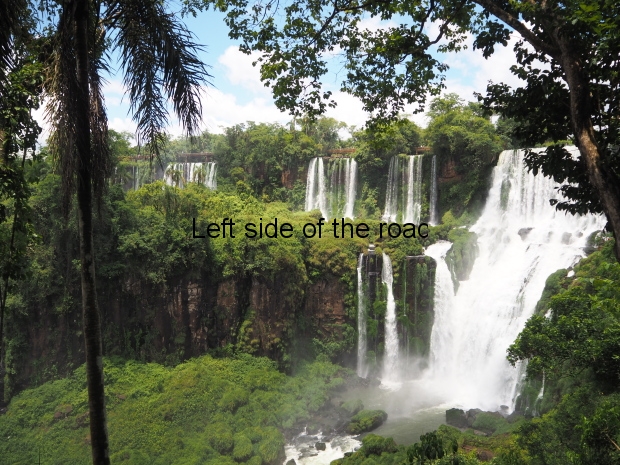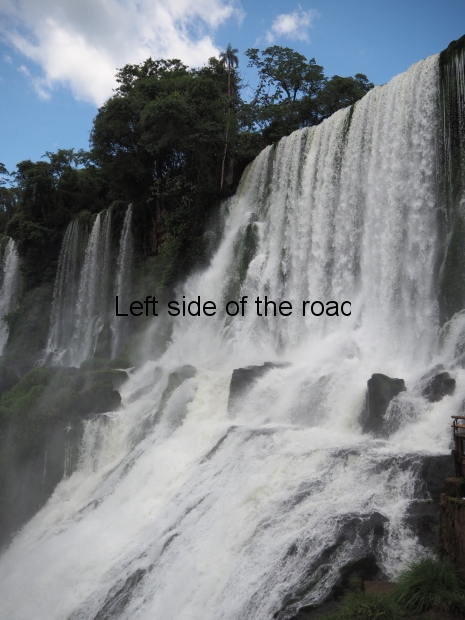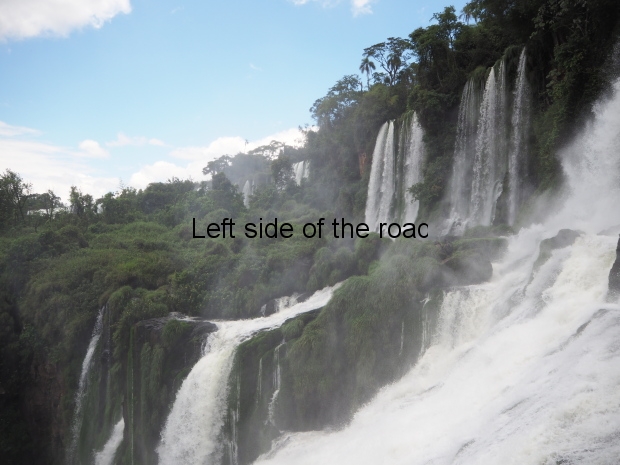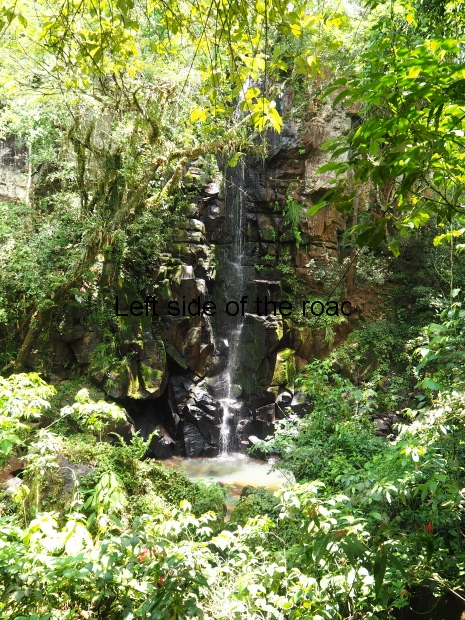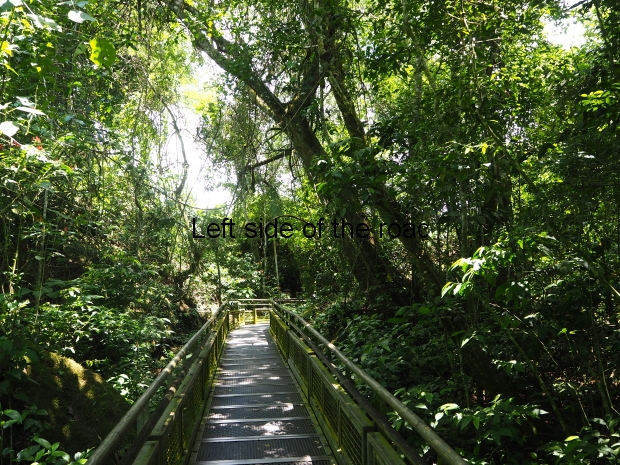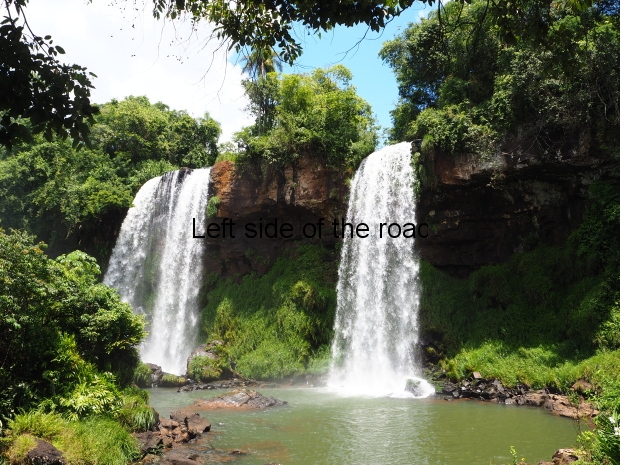
First view of Iguazu Falls – Brazil
Iguazu Falls – from Brazil and Argentina
If you are anywhere near the Misiones province of north-east Argentina then it’s a ‘must’ to go and see the Iguazu Falls. Superlatives abound when they have been described in the past – but they don’t disappoint. They fall within the border between Brazil and Argentina (with the majority in Argentina) and if possible you should try to see the falls from both sides. You are only watching water flow but you won’t get bored as around the corner it’s doing it in a different and often more spectacular manner.
If possible I would suggest you try to see the falls from the Brazilian side first in order to get a panoramic view of them and then (the next day) visit the National Park in Argentina where you can get close up in a way that’s impossible in Brazil. (The Practical Details involved in visiting the two sides are at the end of the post.)
There are so many people visiting both parks in the summer that any animals you might see are only the ones that have become used to humans as a source (either willingly or unwittingly) of free food. The coati (from my experience) have become more bold and aggressive and despite all the signs about not feeding them they will literally snatch food from out of the hands of the unwary. I don’t know if some of the more forward might not be culled at various times of the year – otherwise the ‘wild’ population would become totally dependent upon scraps from tourists. But some of the birds, and especially the butterflies (on my visit), were amazing.
To see any of the other, larger mammals you would have to be there first thing in the morning before the arrival of the crowds or (if possible) pick you time to visit when it’s the low season.
The Brazilian Side
You are much more constrained in the Brazilian National Park than when you visit the falls in Argentina – unless you take one of the many not-so-cheap add-on tours that are on sale. You have to queue and get on a bus getting off close to the pink Hotel das Cataratas – ignore the first two stops which are just for the extra tours.
From there you join a path which follows the banks of the river as it gets closer to the outflow from the Garganta del Diablo (Devil’s Throat). The videos below will, I hope, give some idea of what you would see.
In the next video you will be able to see groups of people standing on a platform right over the water. This walkway is part of the Upper Trail you can take and gives you an idea of the different experience awaiting you on a visit to the Argentinian National Park, from Puerto Iguazu.
Go on a crowded Sunday in January, as I did, and you will be fighting to get a view with the people wanting to take selfies. Just behind the rising plume of spray you can see people on the walkway heading to the Garganta del Diablo in Argentina.
One of the amazing things about Iguazu is that you have the huge waterfalls and countless other smaller, yet in any other context significant, falls wherever you look.
This is the closest you get the falls on the Brazilian side. You’re looking up at the Garganta del Diablo and getting wet.
It’s a true fight to get space at the end of the walkway. You see nothing, as the spray is so intense, but it will give you a feeling of the force of the water – and the noise.
The Argentinian Side

Parque Nacional Iguazu – Argentina
Considering that if you could only go to one side of the falls you would want to choose the Argentinian the experience of entering the Parque Nacional Iguazú from Puerto Iguazú is much more pleasant and relaxed. This is obvious as soon as you get off the bus.
Here there is no huge esplanade that is capable of taking queues of hundreds for the ticket office and then the bus. Here it is quiet and what you would expect on entering a national park as opposed to a Disney-style theme park. Here the crowds soon disappear into the various ways that people can enjoy the surroundings.
Yes, there are bottlenecks at the two railway stations that take those who don’t want to walk to the closest land point to the Garganta del Diablo and possible bottlenecks along the walkway itself but nothing as compared to the other side of the river. You see much more, have an experience of walking in a jungle environment, albeit along constructed walkways, and get a better impression of the scale of the place you are in. And it’s cheaper to visit – in fact all the National Parks in Argentina are cheaper than they are in neighbouring Chile and Brazil. Added to that you can get a printed plan of the park from the Visitor’s Centre (see above).
Garganta del Diablo
To get to the main attraction it’s possible to take the small narrow gauge railway the 2.5 kilometres from Cataratas Station or you can walk it in a little over half an hour. The route is easy enough to find, you just walk beside the railway track. The walk means you don’t have to fight to get on the train and as it only runs every half an hour you can walk it in the time it takes to wait for the next one. From the Garganta Station it’s another 15 minute walk, more or less, (depending upon the crowds) to the platform that looks into the Devil’s Throat.
Views of the ‘minor’ falls
As can be seen from the previous videos the Garganta del Diablo is not the only waterfall at Iguzu and in order to get a close view of some of the others a quite intricate, but relatively subtle, system of walkways has been created to allow people to get close to the water before it thunders down yet another precipice. Often hidden by the undergrowth these walkways make the park accessible without being too intrusive. Obviously there are times when these walkways come out into the open (especially the one to the Garganta del Diablo as it crosses the open river) but much of the time the heavy vegetation hides most of the structure – at least the second system since the falls were made accessible to the public.
There are two main trails, the Upper and the Lower.
The Upper Trail
And a bit further along:
(I didn’t notice the Great White Egret at the very end of the clip until I reviewed what I had filmed later on – a pity that.)
The Lower Trail
And a final Iguazu Falls video.
Practical details
Cataratas do Iguaçu (The Brazilian Viewpoint)
If you can at all help it DON’T visit the Cataratas do Iguaçu in January, and especially not on a Sunday, as I did. Unless you are very strategic the queues can be horrendous. The suggestions made below are based on someone being based in Puerto de Iguazu (Argentina) who wishes to see the falls from Brazil.
Nothing is really difficult here it just means that with a little forethought (which I lacked having arrived after dark and didn’t think to check departure details until the following day) and planning a lot of the stress and frustration can be taken out of the trip.
Take the first bus from Puerto de Iguazu bus station at 07.30. The local (as opposed to the long distance) buses leave from over the green metal bridge on the right hand side of the bus station as you enter it from Avenida Cordoba.
At the bottom of the ramp there’s the ticket booth of the Rio Uruguay bus company, who run one of the regular routes to both the falls on the Brazilian and Argentinian side. Get your ticket before you try to get on the bus – the driver will take cash but it speeds things up if you already have a ticket. The fare is AR$ 130 each way. Get a return, (ida y vuelta).
The buses leave on the half hour, every hour from both ends of the journey and take just under an hour – taking into account the border formalities. (If you take the 07.30 bus from the Puerto you will arrive just under 30 minutes after the ticket office has opened and it should be very quiet.)
When the bus arrives at the Argentinian immigration ALL passengers have to get off and go through the well staffed and efficient (although somewhat cramped) passport hall. You will get an exit stamp in your passport. Get back on the bus and everyone should be in and out in less than 10 minutes.
The bus then goes to the Brazilian immigration and customs. Here everyone BUT Argentinian citizens have to get off and go through the entry process. (Argentinians (and presumably Brazilians) wanting to visit the neighbouring country for less than 24 hours don’t have to get stamps in their passports – the reason for them getting off and having their identity cards checked on leaving Argentina is to make sure there’s nothing untoward). People leaving Argentina to start a trip in Brazil are unlikely to have their luggage checked – although don’t bank on it. Every so often there might be a bit of a purge.)
Get back on the bus and, again, this process should be over in 10 minutes. It’s about 15 more minutes to the Visitors’ Centre. (My driver seemed to want to get people to buy tickets for the Parque das Aves, just outside the entrance to the falls. My information is that it’s not really worth it, especially for indigenous breeds. And it delays you getting to your main objective.)
Once at the Visitors’ Centre there are two ways to get your tickets.
The first, and the quickest in most circumstances, is from the self-service ticket machines that are just to the left of the bus stop. There you will find about 6 blue machines. Fairly straightforward if you have a Visa or Mastercard Debit/Credit Card. You’re snookered if your card is not – mine wasn’t, when I just assumed it was, and wasted time standing in one long queue when I should have been wasting my time standing in an even bigger queue.
The second is the general ticket windows. They will accept Brazilian Rials, Argentinian Pesos or US Dollars. To confuse things even more the ticket cost me, more or less, the equivalent of £18.00 (or AR$ 862). Strangely I was asked for my passport and it was actually photographed and stored on the computer system. Why that was necessary is beyond me. Perhaps if the waterfall was to go missing during the day they had a list of suspects.
(The number of times our personal details are being recorded is phenomenal. Eat your heart out Stasi. What you did was nothing as compared to modern states – those vassal states, such as Argentina and the UK, sending all this information to the Department for Homeland Security in the USA. A visit to a waterfall obviously counting as a terrorist training activity.)
Once bought you have to queue at the embarkation gate to get on a bus to take you into the National Park. If early in the morning this should be a breeze – also after about 14.00.
There are two stops before you arrive at the large Hotel das Cataratas. Those stops are for extra excursions not included in the park entrance fee – and if you had paid for them you would probably have been taken to the area in your own bus. You get of the bus at the huge hotel and there’s a trail that starts dropping down from the road about a 100 metres after the bus stop, where you immediately get an idea of the extent of the falls.
This route will take you along a path which reveals more of what is on offer, eventually coming down close to the river where there’s a pedestrian bridge taking you quite a way into the river and a view, and feel, of the spray created by the biggest fall, the Garganta del Diablo. If you go that far you will get wet.
From that low point you can either take the lift up to the road level or walk back a short distance and take the route marked as ‘Exit’ which brings you to the same place. The queues to come back will move a lot faster as there seems to be a limit on the numbers of people arriving, especially when it is very busy, so as not to create huge log jams of people at the various viewpoints. Once you have finished the aim is to get you out as quickly as possible.
I didn’t test out any of the food and drink places at the visitors’ centre – or at the end of the trail by the return bus stop.
Once out of the park the bus back to Puerto de Iguazu leaves from where you got off. Although Argentinians are into queuing normally even they will leave their culture behind at this bus stop. At least 50% of the passengers will be foreigners with no tradition of queuing and everyone knows that it’s not a matter of getting on the bus it’s a matter of getting seat.
The process through immigration is the same as coming. Argentinians stay on the bus at the Brazil immigration (and take the seats of those who have to get off if they didn’t have one in the first place) and it’s an even bigger scrum at the Argentinian immigration as their identity cards are checked quicker than foreign passports. Then either with or without a seat you head back to Puerto de Iguazu. Normally all it has cost you over and above the park entrance fees is a lost page in your passport.
Cataratas del Iguazú (the Argentinian viewpoint)
The bus leaves from the same place as for the trip to the Brazilian Falls and the bus is operated by the same company. (There are other companies that make these trips but Rio Uruguay was the one I used.) The cost is AR$ 130 each way, and as above get a return – although the Argentinian Park being quieter there would be no problem in getting a ticket in the office by the bus stop at the park entrance.
Nominally the buses run every half hour, on the hour and half hour but in January the frequency was increased to every 20 minutes and they were doubling up of buses at the busy time around 09.00-10.00. Obviously the earlier the bus the less crowded will be the park when you arrive. The journey takes about 45 minutes.
The ticket windows (only 3 or 4 of them) are just back from the bus stop and the queues are nothing like they are in Brazil – that was crazy. Entrance for a foreign national adult is AR$ 700 – about £14.00.
Once with ticket just walk through the automated barriers and you can go where you want. The Visitors Centre is about 400m into the park on the right hand side where you can pick up a paper plan. My recommendation is – whatever time you arrive – that you head for the Garganta del Diablo first, either by the train or by walking. It is THE area to see and you don’t want to leave yourself short of time.
After the Garganta del Diablo head back to the Cataratas Station and pick up the path that leads to the two walkways – the red one on the map which is the Upper Circuit and the blue one which is the Lower Circuit. Both are worth the effort.
There are a number of eating and drinking places around the area of the Central Rail Station towards the entrance.
Buses back to Puerto de Iguazu are timetabled the same as leaving the town but in the height of the season more will be made available. The company seems to be able to predict when it needs extra buses as they weren’t just responding at the last minute in the bus station. They know from experience how much time the majority of people will stay in the park and will schedule the buses accordingly.


